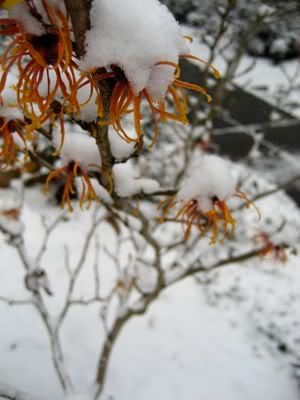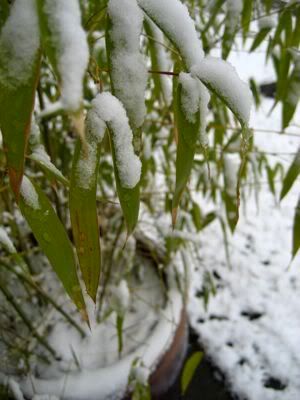Yay! DH started working on the cold frames. I'll have three, one at the end of each bed. They're small but should work out just fine. (4' x 1.5') He built the bottom part of each one and made me go find another window for the third one. I was only going to have two but he thought since he was makin' stuff there should be three. I'm bummed I couldn't find a third window that was the right size. It was nuts at the rebuilding place and there was no one to help plus I had an untethered, curious, disobedient toddler in tow who kept running off to look at all the really neat stuff. Ug. They also had a tape measure by the check stand that you could use when I was there yesterday but it was gone today. I guess someone was off using it. That'll teach me. I should've brought my own. So I was trying to eyeball sizes. I didn't guess right and bought a smaller window. It was 2' x 3' instead of 2' x 4'. Ah well... I guess I'll have a little flower or herb bed at the end of the one raised beds. I'm actually perfectly okay with that.
DH also worked on the compost bins a little more. However those still aren't done. I chucked my kitchen scraps in there today anyway! He needs to make the sides that slide in and out still and the lids. The base frame is complete. I'm so happy with how the back yard is coming together! The next thing I need to do is work on making the gravel paths. I actually also finally got around to amending the raised beds with dolomite lime and cottonseed meal. Yes I tilled by hand. It's probably not as deep as with a tiller but that's okay cause I still need to add some more compost to two of the beds so i'll be deeper when I chuck compost on top - ha! And yes I know I owe you some pictures. Once the frames are complete I'll post some.
One Mud Monkey's Adventure in Organic Gardening
“Gardening is the art that uses flowers and plants as paint, and the soil and sky as canvas.”
-Elizabeth Murray
Saturday, January 31, 2009
Thursday, January 29, 2009
Oh the lure of the seed catalogs...
I'm so besided! I just placed an order for a bunch of seeds and asparagus crowns for early season planting. Weeee!
Now I better really get my tail in high gear! I need to set up a seed starting "bench" which I've been meaning to do but ya know, there's always tomorrow... well tomorrow is here! Crapolla! Amending the soil should've happened last fall too. Guess I'll get out and try to lime and add some cottonseed meal I have laying around. I really wish I had a tiller... hoeing by hand is such a PITA. Ah well...
It really did make me happy to get some of my seed order placed. I picked up some artichokes, french beans, peas, broccoli, celery, leeks, lettuce, spinach and blew a wad on asparagus crowns which are DH's all time favorite veggie. So can't really go without that - had to make all that work of building the beds pay off for him somehow! Not sure I'll need all 25 crowns but they didn't come in any smaller numbers. I've also got to talk DH into building me a cold frame. Shouldn't be too much trouble, right?
I'll be sure to add details of each cultivar in subsequent posts. All can be found together with a click on the Eatable Plant List Label.
Now I better really get my tail in high gear! I need to set up a seed starting "bench" which I've been meaning to do but ya know, there's always tomorrow... well tomorrow is here! Crapolla! Amending the soil should've happened last fall too. Guess I'll get out and try to lime and add some cottonseed meal I have laying around. I really wish I had a tiller... hoeing by hand is such a PITA. Ah well...
It really did make me happy to get some of my seed order placed. I picked up some artichokes, french beans, peas, broccoli, celery, leeks, lettuce, spinach and blew a wad on asparagus crowns which are DH's all time favorite veggie. So can't really go without that - had to make all that work of building the beds pay off for him somehow! Not sure I'll need all 25 crowns but they didn't come in any smaller numbers. I've also got to talk DH into building me a cold frame. Shouldn't be too much trouble, right?
I'll be sure to add details of each cultivar in subsequent posts. All can be found together with a click on the Eatable Plant List Label.
Jersey Knight Asparagus (Crowns)
This all-male variety yields the highest quality spears of the Jersey hybrids. Developed on the East Coast, Jersey Knight performs well all across the US. Jersey Knight is highly resistant to rust, Fusarium, root rot, crown rot and Cercospora. It is also hardy in cold winter climates where the soil freezes solid. Will overwinter to zone 3. HV
Asparagus officinalis: This Mediterranean native is one of the first vegetables harvested in the spring. Asparagus is easy to start from seed, but you'll get an earlier harvest from 1 year old crowns. Enjoy steamed, served with butter or lightly drizzled with hollandaise sauce.
CULTURE: Direct seeding is not recommended. Start transplants 60-90 days before your last frost. Sow seeds 1/4 inch deep in sterile seedling mix kept at 65-80°F. Germination can take up to 21 days. Fertilize transplants with an all purpose liquid fertilizer.
PREPARING THE BED: The key to good production is a well-prepared, deeply dug bed with lots of added organic matter. Prior to transplanting, work in 1-2 cups of our complete fertilizer per 10 row feet. After the danger of frost has passed, plant seedlings 10-15 inches apart in a 4 inch deep trench. Fill in the trench as the asparagus grows.
Asparagus Root Crowns: Plant the crowns shortly after you receive them in mid-April. Complete instructions are included with your order.
MAINTAINING THE BED: Fertilize an established bed early in the spring and after harvest with 1-2 cups of our complete fertilizer per 10 row feet. Keep beds moist with about 1 inch of water per week. Stop harvesting when the stalks reduce in size to the diameter of a pencil. Let the smaller remaining spears grow. They may reach 5-7 feet tall and will become bushy. Cut off ferny growth to the ground after it turns yellow. Mulch with 2-3 inches of compost or well rotted manure in the fall.
DISEASE: The main diseases of asparagus are rust, Fusarium wilt, and Fusarium stem and crown rot. Control by starting seeds in sterile soil and maintaining good plant vigor.
INSECTS: Control asparagus beetles with an application of 5% Rotenone. Slugs may also be troublesome in the early spring, so use traps or bait to keep their munching to a minimum.
HARVEST: A moderate 2-3 week harvest can be expected from crowns in 2-3 years. Harvest spears when they are 6-10 inches tall, breaking or cutting them off at ground level. With each successive year, your harvest window will lengthen to a maximum of 6-8 weeks. Harvested spears can be held for 10 days at 34°F and 100% relative humidity.
SEED SPECS: Minimum germination standard: 75%. Usual seed life: 3 years."
----------
DAYS TO MATURITY: Harvest begins three years after planting (seed).
WHEN TO PLANT: Seed may be started indoors but are most commonly sown in the garden, often in a special nursery row, either in the fall or in the spring, about the time apple blossom petals begin to fall.
HOW TO PLANT: Soak the seeds in water overnight before planting, to soften the tough seed coats. The tiny, feathery seedlings look delicate, but they transplant well. Sow seeds 1" - 2" apart in a nursery bed. Transplant the plants out of the nursery row no later then the second year because older plants grow deep roots which must be sacrificed in digging up. Transplant them about 15" apart, in rows 3' - 4' apart. We know now that the heroic measures formerly used to plant asparagus on soil mounds in 18" deep trenches are not necessary. Roots planted 2"-8" deep do just as well. You can even set the crowns on the soil surface and mound 3" ridges of soil above them, according to some researchers, who say that although the effect of this method on asparagus yields has not been studied, crown survival was excellent.
GROWING CONDITIONS: The permanent asparagus bed can be well prepared while the seedlings are growing. Dig in plenty of limestone and well rotted manure and make certain the ground is well drained and well aerated. Plants that produce male flowers are somewhat more productive than the berry producing females so some growers cull out berried asparagus plants. mulch the bed and wait until the second year to take your first two to three week harvest. After five years you can pick for ten weeks.
----------
PURCHASED: 25 1 year old crowns from Territorial Seed Co. Jan '09. Will ship mid April direct from grower. $29.95
STARTED SEED: n/a
HARDENED OFF: n/a
TRANSPLANTED IN GARDEN:
DISEASE ISSUES:
INSECT ISSUES:
HARVEST YEILD & DURATION:
OTHER NOTES:
Asparagus officinalis: This Mediterranean native is one of the first vegetables harvested in the spring. Asparagus is easy to start from seed, but you'll get an earlier harvest from 1 year old crowns. Enjoy steamed, served with butter or lightly drizzled with hollandaise sauce.
CULTURE: Direct seeding is not recommended. Start transplants 60-90 days before your last frost. Sow seeds 1/4 inch deep in sterile seedling mix kept at 65-80°F. Germination can take up to 21 days. Fertilize transplants with an all purpose liquid fertilizer.
PREPARING THE BED: The key to good production is a well-prepared, deeply dug bed with lots of added organic matter. Prior to transplanting, work in 1-2 cups of our complete fertilizer per 10 row feet. After the danger of frost has passed, plant seedlings 10-15 inches apart in a 4 inch deep trench. Fill in the trench as the asparagus grows.
Asparagus Root Crowns: Plant the crowns shortly after you receive them in mid-April. Complete instructions are included with your order.
MAINTAINING THE BED: Fertilize an established bed early in the spring and after harvest with 1-2 cups of our complete fertilizer per 10 row feet. Keep beds moist with about 1 inch of water per week. Stop harvesting when the stalks reduce in size to the diameter of a pencil. Let the smaller remaining spears grow. They may reach 5-7 feet tall and will become bushy. Cut off ferny growth to the ground after it turns yellow. Mulch with 2-3 inches of compost or well rotted manure in the fall.
DISEASE: The main diseases of asparagus are rust, Fusarium wilt, and Fusarium stem and crown rot. Control by starting seeds in sterile soil and maintaining good plant vigor.
INSECTS: Control asparagus beetles with an application of 5% Rotenone. Slugs may also be troublesome in the early spring, so use traps or bait to keep their munching to a minimum.
HARVEST: A moderate 2-3 week harvest can be expected from crowns in 2-3 years. Harvest spears when they are 6-10 inches tall, breaking or cutting them off at ground level. With each successive year, your harvest window will lengthen to a maximum of 6-8 weeks. Harvested spears can be held for 10 days at 34°F and 100% relative humidity.
SEED SPECS: Minimum germination standard: 75%. Usual seed life: 3 years."
----------
DAYS TO MATURITY: Harvest begins three years after planting (seed).
WHEN TO PLANT: Seed may be started indoors but are most commonly sown in the garden, often in a special nursery row, either in the fall or in the spring, about the time apple blossom petals begin to fall.
HOW TO PLANT: Soak the seeds in water overnight before planting, to soften the tough seed coats. The tiny, feathery seedlings look delicate, but they transplant well. Sow seeds 1" - 2" apart in a nursery bed. Transplant the plants out of the nursery row no later then the second year because older plants grow deep roots which must be sacrificed in digging up. Transplant them about 15" apart, in rows 3' - 4' apart. We know now that the heroic measures formerly used to plant asparagus on soil mounds in 18" deep trenches are not necessary. Roots planted 2"-8" deep do just as well. You can even set the crowns on the soil surface and mound 3" ridges of soil above them, according to some researchers, who say that although the effect of this method on asparagus yields has not been studied, crown survival was excellent.
GROWING CONDITIONS: The permanent asparagus bed can be well prepared while the seedlings are growing. Dig in plenty of limestone and well rotted manure and make certain the ground is well drained and well aerated. Plants that produce male flowers are somewhat more productive than the berry producing females so some growers cull out berried asparagus plants. mulch the bed and wait until the second year to take your first two to three week harvest. After five years you can pick for ten weeks.
----------
PURCHASED: 25 1 year old crowns from Territorial Seed Co. Jan '09. Will ship mid April direct from grower. $29.95
STARTED SEED: n/a
HARDENED OFF: n/a
TRANSPLANTED IN GARDEN:
DISEASE ISSUES:
INSECT ISSUES:
HARVEST YEILD & DURATION:
OTHER NOTES:
Labels:
Asparagus,
Eatable Plant List,
HV,
kitchen garden,
Territorial Seed Co.
Hybrid Broccoli Blend
Hybrid Broccoli Blend
55-100 days. We mix four very flavorful, tender varieties together for a harvest period of about two months from a single sowing date. Contains Belstar, Everest, Southern Comet, and Packman. If the broccoli fancier makes one spring sowing and one more in late May/early June, a nearly continuous harvest of big, succulent heads will be enjoyed until fall. Thin carefully, as some varieties grow faster than others. HV
Belstar Broccoli
66-75 days. Flawlessly uniform, 6-inch heads are beautiful blue-green, densely packed florets. The tightly domed heads are held high off the plants for easy harvest. This variety has excellent field holding capacity and is ideal for both warm and cold weather planting. It performed so well in our trials that it would have been a sin not to offer it.
Southern Comet Broccoli
80 days. One of the best producers of all our early spring hybrids. Sturdy forest green heads are ready to harvest when 6-8 inches in diameter. The skin is so thin and tender and the flavor so sweet, it is a must for the gardening gourmet and well suited for local farmer's market sales. Grows 14-16 inches tall and offers good side shoot production.
Packman
55 days. An early-maturing hybrid, Packman produces a large, sage green central head quickly with harvestable side shoots forming soon after the central head is cut. The 9 inch crowns of Packman are extremely uniform. They are tight with medium beading, a very handsome variety for both the home gardener and the roadside market. Relatively tall plants reach 27 inches high.
Everest
100 days
Brassica oleracea, Botrytis Group: Broccoli is sometimes called the luxury crop because it's so easy to grow and it has a million dollar taste. By sowing several varieties that have a sequence of maturity dates, you can have a continual harvest through late fall and even over winter into spring from just one or two plantings.
Brassica rapa, Ruvo Group
CULTURE: When compared with the rest of the cole crops, broccoli is generally the most vigorous and trouble free to grow. However, early plantings are essential because it lacks tolerance to extreme heat. Generally cole crops are tolerant of the acidic soils. Maintaining a pH of 6.0-6.8 will make the best use of the available nutrients.
FOR TRANSPLANTS: Start broccoli indoors or in the greenhouse about the first of February for transplanting in mid-March. Sow the seed in a sterile seedling mix, 1/4 inch deep, in individual pots. The optimum soil temperature range is 55-75°F. Days to emergence: 5-17. Keep the seedlings moist, and provide adequate nutrition. Harden off seedlings in a cold frame prior to transplanting. Set the seedlings 12-24 inches apart, in rows 18-36 inches apart. Side-dress with 1/2 cup blood meal or composted chicken manure. Young seedlings may be covered with a cloche or row cover such as Gro-Therm or Reemay. Be watchful for early hot spells, because covers can create too much heat if left unchecked.
TO DIRECT SOW: Broccoli can be directly seeded from April through mid July. Sow the seed 1/2 inch deep, 4 inches apart, in rows 18-36 inches apart. Cover the seed with loose soil or sifted compost. Keep the seedbed uniformly moist as rough heads or leaves in the head are usually from heat-stressed seedlings. Thin plants to 12-24 inches apart and work in 1/4-1/2 cup of our complete fertilizer or equivalent around the base of each plant. INSECTS: See Brassica Insect Information in the box below.
DISEASE: The home gardener can help prevent viral and fungal broccoli diseases by practicing long crop rotations, using sterile starting mixes if transplanting, and practicing general sanitation procedures.
HARVEST: Before flower buds open, cut the central head at a 45°F angle. Side shoots will form from the axillary buds and should be cut regularly to encourage production. Store at 40°F and 95% relative humidity.
SEED SPECS: Minimum germination standard: 80%. Days to maturity are calculated from transplanting date; add 25-35 days if direct seeded. Usual seed life: 3 years. Approximately 125-175 seeds per 1/2 gram, about 250-350 seeds per gram; 28 grams per ounce.
----------
WHEN TO PLANT: An early start on this cool weather annual will give you fine quality green heads before uniformly hot weather reigns. Plants seeds thinly in flats about five to six weeks before planting them outside, which can be up to a month beofre your last expected frost. Broccoli can withstand frost down to about 25°F. It grows best at 60°F to 65°F. Make an early summer planting - directly in the row if you wish to produce fresh new plants for fall eating.
HOW TO PLANT: Transplant the seedlings at least once into larger flats and set out young plants 18"-24" apart, in rows about 24" apart. Broccoli plants spaced 10"-12" apart will also yield well but have smaller heads.
GROWING CONDITIONS: Failure ot produce heads can be caused by hot weather, lack of water and low soil calcium.
PESTS: Cutworms, flea beetles and cabbage moth larvae are common enemies of the broccoli seedling.
VARIETIES: Green Comet or premium Crop for spring planting are good varieties. Waltham 29 is still a good fall broccoli.
----------
PURCHASED: 1g from Territorial Seed Co. Jan '09. $3.95
STARTED SEED: 2/5/09, 9 pm - one batch with heating mat (82° - consistent) one without (72° / next morning 62°). Seeds germinated much better in the cooler flat maybe 80% or so. The hotter mat had a rate of about 20% or less! Though both were showing signs of life by 2/7 - 2 days - not bad!
HARDENED OFF: 3/15/09: One hour in the cold frame.
TRANSPLANTED IN GARDEN:
DISEASE ISSUES:
INSECT ISSUES:
HARVEST YEILD & DURATION:
OTHER NOTES: Thought this would be a good way to check out different kinds of broccoli, that is w/ small mix of four varieties - just hope I'll be able to tell them apart when it comes down to it! I'll try to go by days to maturity to determine which one's which - hope I also don't thin one or two out in the process. I've only tried broccoli one other time when I was first getting into gardening and I know now that I planted it way too late in the season so it just gave up the ghost on me, poor dear. Hope I have better luck this time around.
2/8/09
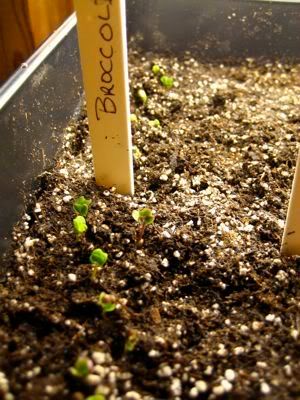
2/23/09
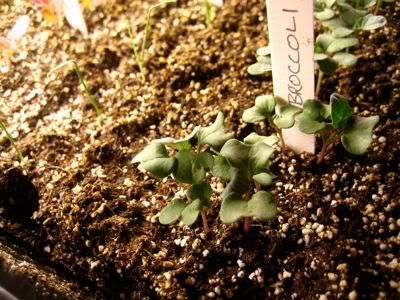
03/02/09
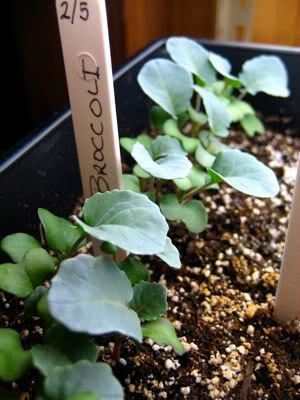
03/16/09
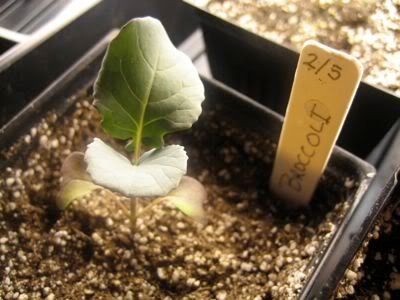
03/23/09
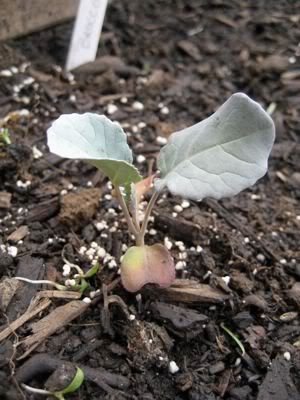
03/30/09

55-100 days. We mix four very flavorful, tender varieties together for a harvest period of about two months from a single sowing date. Contains Belstar, Everest, Southern Comet, and Packman. If the broccoli fancier makes one spring sowing and one more in late May/early June, a nearly continuous harvest of big, succulent heads will be enjoyed until fall. Thin carefully, as some varieties grow faster than others. HV
Belstar Broccoli
66-75 days. Flawlessly uniform, 6-inch heads are beautiful blue-green, densely packed florets. The tightly domed heads are held high off the plants for easy harvest. This variety has excellent field holding capacity and is ideal for both warm and cold weather planting. It performed so well in our trials that it would have been a sin not to offer it.
Southern Comet Broccoli
80 days. One of the best producers of all our early spring hybrids. Sturdy forest green heads are ready to harvest when 6-8 inches in diameter. The skin is so thin and tender and the flavor so sweet, it is a must for the gardening gourmet and well suited for local farmer's market sales. Grows 14-16 inches tall and offers good side shoot production.
Packman
55 days. An early-maturing hybrid, Packman produces a large, sage green central head quickly with harvestable side shoots forming soon after the central head is cut. The 9 inch crowns of Packman are extremely uniform. They are tight with medium beading, a very handsome variety for both the home gardener and the roadside market. Relatively tall plants reach 27 inches high.
Everest
100 days
Brassica oleracea, Botrytis Group: Broccoli is sometimes called the luxury crop because it's so easy to grow and it has a million dollar taste. By sowing several varieties that have a sequence of maturity dates, you can have a continual harvest through late fall and even over winter into spring from just one or two plantings.
Brassica rapa, Ruvo Group
CULTURE: When compared with the rest of the cole crops, broccoli is generally the most vigorous and trouble free to grow. However, early plantings are essential because it lacks tolerance to extreme heat. Generally cole crops are tolerant of the acidic soils. Maintaining a pH of 6.0-6.8 will make the best use of the available nutrients.
FOR TRANSPLANTS: Start broccoli indoors or in the greenhouse about the first of February for transplanting in mid-March. Sow the seed in a sterile seedling mix, 1/4 inch deep, in individual pots. The optimum soil temperature range is 55-75°F. Days to emergence: 5-17. Keep the seedlings moist, and provide adequate nutrition. Harden off seedlings in a cold frame prior to transplanting. Set the seedlings 12-24 inches apart, in rows 18-36 inches apart. Side-dress with 1/2 cup blood meal or composted chicken manure. Young seedlings may be covered with a cloche or row cover such as Gro-Therm or Reemay. Be watchful for early hot spells, because covers can create too much heat if left unchecked.
TO DIRECT SOW: Broccoli can be directly seeded from April through mid July. Sow the seed 1/2 inch deep, 4 inches apart, in rows 18-36 inches apart. Cover the seed with loose soil or sifted compost. Keep the seedbed uniformly moist as rough heads or leaves in the head are usually from heat-stressed seedlings. Thin plants to 12-24 inches apart and work in 1/4-1/2 cup of our complete fertilizer or equivalent around the base of each plant. INSECTS: See Brassica Insect Information in the box below.
DISEASE: The home gardener can help prevent viral and fungal broccoli diseases by practicing long crop rotations, using sterile starting mixes if transplanting, and practicing general sanitation procedures.
HARVEST: Before flower buds open, cut the central head at a 45°F angle. Side shoots will form from the axillary buds and should be cut regularly to encourage production. Store at 40°F and 95% relative humidity.
SEED SPECS: Minimum germination standard: 80%. Days to maturity are calculated from transplanting date; add 25-35 days if direct seeded. Usual seed life: 3 years. Approximately 125-175 seeds per 1/2 gram, about 250-350 seeds per gram; 28 grams per ounce.
----------
WHEN TO PLANT: An early start on this cool weather annual will give you fine quality green heads before uniformly hot weather reigns. Plants seeds thinly in flats about five to six weeks before planting them outside, which can be up to a month beofre your last expected frost. Broccoli can withstand frost down to about 25°F. It grows best at 60°F to 65°F. Make an early summer planting - directly in the row if you wish to produce fresh new plants for fall eating.
HOW TO PLANT: Transplant the seedlings at least once into larger flats and set out young plants 18"-24" apart, in rows about 24" apart. Broccoli plants spaced 10"-12" apart will also yield well but have smaller heads.
GROWING CONDITIONS: Failure ot produce heads can be caused by hot weather, lack of water and low soil calcium.
PESTS: Cutworms, flea beetles and cabbage moth larvae are common enemies of the broccoli seedling.
VARIETIES: Green Comet or premium Crop for spring planting are good varieties. Waltham 29 is still a good fall broccoli.
----------
PURCHASED: 1g from Territorial Seed Co. Jan '09. $3.95
STARTED SEED: 2/5/09, 9 pm - one batch with heating mat (82° - consistent) one without (72° / next morning 62°). Seeds germinated much better in the cooler flat maybe 80% or so. The hotter mat had a rate of about 20% or less! Though both were showing signs of life by 2/7 - 2 days - not bad!
HARDENED OFF: 3/15/09: One hour in the cold frame.
TRANSPLANTED IN GARDEN:
DISEASE ISSUES:
INSECT ISSUES:
HARVEST YEILD & DURATION:
OTHER NOTES: Thought this would be a good way to check out different kinds of broccoli, that is w/ small mix of four varieties - just hope I'll be able to tell them apart when it comes down to it! I'll try to go by days to maturity to determine which one's which - hope I also don't thin one or two out in the process. I've only tried broccoli one other time when I was first getting into gardening and I know now that I planted it way too late in the season so it just gave up the ghost on me, poor dear. Hope I have better luck this time around.
2/8/09

2/23/09

03/02/09

03/16/09

03/23/09

03/30/09

Labels:
100 days,
55 days,
66-75 days,
80 days,
broccoli,
Eatable Plant List,
Fall Crop,
HV,
kitchen garden,
Territorial Seed Co.
Bloomsdale Savoy Spinach
50 days. Thick, succulent, dark-green, savoyed leaves are very sweet in salads. Bloomsdale is the standard for garden-fresh flavored spinach. When planted in autumn it will overwinter and mature in the early spring. Moderate bolt resistance; best sown in early spring for late spring/early summer harvests.
Spinacia oleracea: Some of the finest spinach varieties available in the world today are developed and produced in Northwest Washington. Determining which of the varieties are superior to others is sometimes a difficult job. Some factors we consider when evaluating a spinach trial are: 1) flavor 2) strong, vigorous growth 3) resistance to forming seed, known as bolting 4) disease resistance.
CULTURE: Spinach requires rich, fertile soil with plenty of organic matter. It is adversely sensitive to uneven moisture and acid soils, and the optimum range is pH 6.5-7.5. Spinach is best grown during the cooler weather of spring and fall. Because nitrogen cycling is slower during cooler temperatures, use fertilizers that release nutrients quickly such as blood meal, fishmeal, bone meal, composted chicken manure, or feather meal. Nitrogen supplied during growth greatly increases the size and quality of your spinach. After the soil has reached 50°F and can be worked, sow seeds 1/2 inch deep and about 1 inch apart, in rows at least 12 inches apart. Optimum soil temperature for germination: 55-65°F. Higher soil temperatures can cause erratic germination. The most favorable air temperatures for spinach are 60-65°F. Days to emergence: 6-21. Keep the bed uniformly moist for best results. Thin to 3 inches between plants. For baby spinach, sow about 35-40 seeds per foot in a 2 inch wide furrow. Thin to 1 inch apart. Pay attention to seasonal difference between varieties. Summer selections are more resistant to bolting, but rising temperatures, longer days, and water or nutrient stress all contribute towards a plant's inclination to bolt. Sow fall varieties in August and September.
HARVEST: For baby greens, harvest when leaves are 3-4 inches. Individual leaves may be harvested any time, or harvest the entire plant when it reaches maturity, just prior to bolting. Rinse in cold water and store at 32°F and 95% relative humidity.
INSECTS/PESTS: If your spinach leaves have a blotchy appearance, chances are you have spinach leaf miners. Destroy any affected leaves and keep the surrounding area weeded.
DISEASE: The key to prevention is planting in fertile soil and using a 3-year crop rotation.
SEED SPECS: Minimum germination standard: 65%. Usual seed life: 1 year. Approximately 80 seeds per gram; 28 grams per ounce.
----------
WHEN TO PLANT: Sow seeds in the ground as early as possible because warm weather and long days all too soon will trigger seed stalk formation. Spinach seeds germinate well in cool soil, and the plants prosper in day temperatures of 60°F dropping to 40°F to 45°F at night.
If your garden is slow to dry for early spring digging, you can prepare your spinach row in the fall, plant the seeds and mulch the row lightly. Gradually rake off the protective covering the following spring. In many areas, fall planted spinach that has grown to a height of an inch or so will winter over under a straw or hay cover. Plant extra hardly varieties like Winter Bloomsdale or Cold Resistant Savory for this purpose.
HOW TO PLANT: Plant the seeds nor more than 1/2" deep and thin the seedlings to stand about 6" apart in rich soil, 8" in leaner soil.
GROWING CONDITIONS: Spinach is a heaver feeder and needs a well aerated, well limed soil. Strongly acid soils often make available substances that are toxic to the plant. In highly alkaline soil, the plants may develop a symptom of manganese deficiency: yellow speckled, curled leaves. Large doses of highly soluble, nitrogen rich fertilizer can increase the oxalate content of spinach - another good reason for applying slow release manure.
DISEASES: If you have trouble with spinach seedlings dying from fungal attack (the fungi like the seed's mucilaginous coating), soak the seeds in a 3:1 chlorine bleach and water solution for ten minutes before planting.
REMARKS: Picking the oldest largest spinach leaves can help to postpone bolting by reducing the amount of the hormone that stimulates production of the seed stalk.
When making later summer plantings for fall eating, you many find that the seeds are reluctant to germinate in warm weather. You can usually induce them to sprout by spreading them between damp paper towels and keeping them in a plastic bag in your refrigerator for five to seven days.
Another nice article on growing spinach
----------
PURCHASED: 5g from Territorial Seed Co. Jan '09. $1.95
STARTED SEED: 2/18/09. Sewn directly in the garden bed. Soil temp 50° air temp about 60°F. I have, three days later, one teeny tiny little sproutling that's come up right where I planted these seeds. I'd love to say it's my spinach but in all honesty, I'm not sure! I'll keep my peepers peeped and confirm when more come up or when it starts to look like spinach and not a weed. 3/7/09 Definitely most of the spinach have sprouted - 17 days! Seems like such a long time. Of course they all come up right before we're getting a change in weather and some snow. It's really late in the season for us to be having snow. I've put little plastic cloches over them to help protect them from the weather we're supposed to get tonight and tomorrow.
HARDENED OFF:
TRANSPLANTED IN GARDEN:
DISEASE ISSUES:
INSECT ISSUES:
HARVEST YEILD & DURATION:
OTHER NOTES:
03/02/09
Did it sprout today? I can't tell...
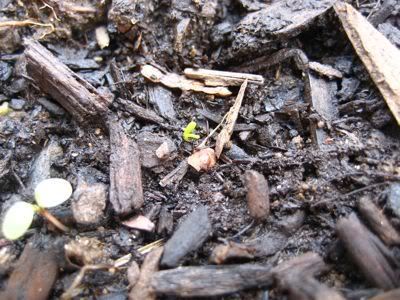
03/16/09
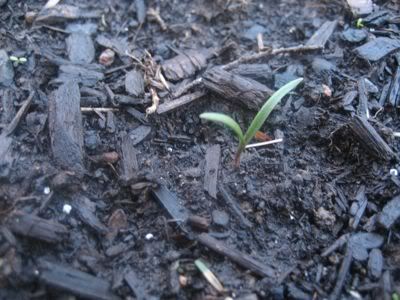
03/23/09
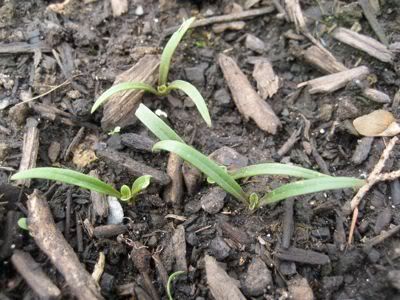
03/30/09
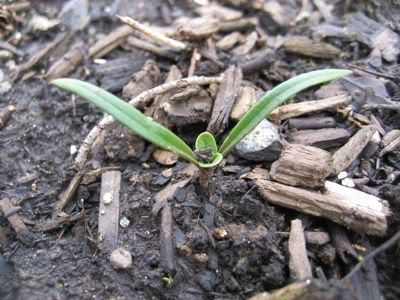
Spinacia oleracea: Some of the finest spinach varieties available in the world today are developed and produced in Northwest Washington. Determining which of the varieties are superior to others is sometimes a difficult job. Some factors we consider when evaluating a spinach trial are: 1) flavor 2) strong, vigorous growth 3) resistance to forming seed, known as bolting 4) disease resistance.
CULTURE: Spinach requires rich, fertile soil with plenty of organic matter. It is adversely sensitive to uneven moisture and acid soils, and the optimum range is pH 6.5-7.5. Spinach is best grown during the cooler weather of spring and fall. Because nitrogen cycling is slower during cooler temperatures, use fertilizers that release nutrients quickly such as blood meal, fishmeal, bone meal, composted chicken manure, or feather meal. Nitrogen supplied during growth greatly increases the size and quality of your spinach. After the soil has reached 50°F and can be worked, sow seeds 1/2 inch deep and about 1 inch apart, in rows at least 12 inches apart. Optimum soil temperature for germination: 55-65°F. Higher soil temperatures can cause erratic germination. The most favorable air temperatures for spinach are 60-65°F. Days to emergence: 6-21. Keep the bed uniformly moist for best results. Thin to 3 inches between plants. For baby spinach, sow about 35-40 seeds per foot in a 2 inch wide furrow. Thin to 1 inch apart. Pay attention to seasonal difference between varieties. Summer selections are more resistant to bolting, but rising temperatures, longer days, and water or nutrient stress all contribute towards a plant's inclination to bolt. Sow fall varieties in August and September.
HARVEST: For baby greens, harvest when leaves are 3-4 inches. Individual leaves may be harvested any time, or harvest the entire plant when it reaches maturity, just prior to bolting. Rinse in cold water and store at 32°F and 95% relative humidity.
INSECTS/PESTS: If your spinach leaves have a blotchy appearance, chances are you have spinach leaf miners. Destroy any affected leaves and keep the surrounding area weeded.
DISEASE: The key to prevention is planting in fertile soil and using a 3-year crop rotation.
SEED SPECS: Minimum germination standard: 65%. Usual seed life: 1 year. Approximately 80 seeds per gram; 28 grams per ounce.
----------
WHEN TO PLANT: Sow seeds in the ground as early as possible because warm weather and long days all too soon will trigger seed stalk formation. Spinach seeds germinate well in cool soil, and the plants prosper in day temperatures of 60°F dropping to 40°F to 45°F at night.
If your garden is slow to dry for early spring digging, you can prepare your spinach row in the fall, plant the seeds and mulch the row lightly. Gradually rake off the protective covering the following spring. In many areas, fall planted spinach that has grown to a height of an inch or so will winter over under a straw or hay cover. Plant extra hardly varieties like Winter Bloomsdale or Cold Resistant Savory for this purpose.
HOW TO PLANT: Plant the seeds nor more than 1/2" deep and thin the seedlings to stand about 6" apart in rich soil, 8" in leaner soil.
GROWING CONDITIONS: Spinach is a heaver feeder and needs a well aerated, well limed soil. Strongly acid soils often make available substances that are toxic to the plant. In highly alkaline soil, the plants may develop a symptom of manganese deficiency: yellow speckled, curled leaves. Large doses of highly soluble, nitrogen rich fertilizer can increase the oxalate content of spinach - another good reason for applying slow release manure.
DISEASES: If you have trouble with spinach seedlings dying from fungal attack (the fungi like the seed's mucilaginous coating), soak the seeds in a 3:1 chlorine bleach and water solution for ten minutes before planting.
REMARKS: Picking the oldest largest spinach leaves can help to postpone bolting by reducing the amount of the hormone that stimulates production of the seed stalk.
When making later summer plantings for fall eating, you many find that the seeds are reluctant to germinate in warm weather. You can usually induce them to sprout by spreading them between damp paper towels and keeping them in a plastic bag in your refrigerator for five to seven days.
Another nice article on growing spinach
----------
PURCHASED: 5g from Territorial Seed Co. Jan '09. $1.95
STARTED SEED: 2/18/09. Sewn directly in the garden bed. Soil temp 50° air temp about 60°F. I have, three days later, one teeny tiny little sproutling that's come up right where I planted these seeds. I'd love to say it's my spinach but in all honesty, I'm not sure! I'll keep my peepers peeped and confirm when more come up or when it starts to look like spinach and not a weed. 3/7/09 Definitely most of the spinach have sprouted - 17 days! Seems like such a long time. Of course they all come up right before we're getting a change in weather and some snow. It's really late in the season for us to be having snow. I've put little plastic cloches over them to help protect them from the weather we're supposed to get tonight and tomorrow.
HARDENED OFF:
TRANSPLANTED IN GARDEN:
DISEASE ISSUES:
INSECT ISSUES:
HARVEST YEILD & DURATION:
OTHER NOTES:
03/02/09
Did it sprout today? I can't tell...

03/16/09

03/23/09

03/30/09

Labels:
50 days,
Eatable Plant List,
Fall Crop,
kitchen garden,
OP,
spinach,
Territorial Seed Co.
Alderman Peas (Tall Telephone)
75 days. Climbs a 6-8 foot trellis. The huge pods, each filled with 6-8 peas, are easy to harvest and shell. Alderman's large peas have that finest-of-all flavor and the plant allows many pickings. A late-maturing variety. OP
Pisum sativum: At Territorial, peas are of special value to us. Our region of the country is well adapted to growing peas, and many of the nation's most popular pea varieties, such as Oregon Sugar Pod II, were developed at Oregon State University. At our research farm, we conduct extensive trials to identify the best tasting and most productive offerings for shelling, snap, and edible pod peas.
CULTURE: A cool-season crop, peas will grow in a variety of soils provided the soil is well drained, in full sun, and contains a sufficient amount of organic matter to allow for good moisture retention. Peas may be sown as soon as the soil can be worked in the spring. They may be planted without rototilling by scratching out a shallow furrow and covering the seed. Sow seeds 1 inch apart, 1-1 1/2 inches deep, in rows 18-24 inches apart. Thinning is not necessary. Optimum soil temperature for germination: 45-75°F. Days to emergence: 6-14. Coat the seed with an inoculant to increase yields. Inoculant enhances early nitrogen-fixing bacterial nodes on the plant roots. Thinning is not necessary. Side dress plants with one cup of our complete fertilizer per 5 row feet along with 1 cup of bone meal per 10 row feet to foster healthy plants for a bountiful harvest. Climbing varieties must be trellised or planted by a fence. New pole-pea varieties in the US are in decline; the new developments are primarily bush types, which are suitable for mechanical harvest. Most bush-type vines can be supported on a short trellis or allowed to grow as a mound. Stress, such as prolonged hot weather or lack of moisture, will cause a higher percentage of off-type plants and reduced yields. We recommend mulching the roots and frequent ground watering (vs. overhead watering) to help keep the roots cool and productive.
DISEASES: Fusarium wilt (also called pea root rot) causes plant foliage to turn brown from the ground up. This can generally be controlled by crop rotation and sowing on well-drained ground. Choosing resistant varieties and ground watering can control powdery and downy mildews. Areas in the Northwest and Northeast are also prone to attacks of pea enation virus, which is spread by the peach aphids that hatch each summer. The virus causes 'windowing' or a mosaic appearance in the leaves, distortion of the pods, and reduced yields. If pea enation is a problem in your garden, we advise sowing enation-resistant varieties. The best control measures are using disease-free seed, selecting disease-resistant cultivars, and practicing crop rotation.
INSECTS: The pea aphid can be a destructive pea insect pest throughout the summer. Applications of Rotenone or Rotenone-Pyrethrin should be started at the seedling stage if leaf scalloping is observed.
HARVEST: Start checking for maturity as soon as the pods begin to swell. If left on the vine too long, the peas become starchy and the pods become tough. Most bush varieties are bred to mature all at the same time for a concentrated, once-over picking. Extend your harvest through multiple sowings. Store peas at 32°F and at 95% relative humidity.
Pea vine tendrils are an important ingredient in stir-fries, Asian salads, and garnishes. Market gardeners pick the top 6-8 inches of pea vines (tendrils) and sell them in bunches. Cascadia, Oregon Giant and Oregon Sugar Pod II were the favorites in trials conducted at Washington State University Extension.
SEED SPECS: Minimum germination standard: 80%. Days to maturity are calculated from the date of direct seeding. Usual seed life: 2 years. Approximately 90-165 seeds per ounce (average 125); 8 ounces per 1/2 pound
----------
WHEN TO PLANT: You can sow early, mid-season, and late varieties on the same day, or make successive plantings of pea seeds throughout the cool weeks of early spring, but there's no point in sowing most kinds of peas later than two to three weeks before the frost free date, because the yield of peas maturing in warm weather seldom justifies the space they take. Young plants grow best at 59°F to 68°F. An exception is Wando, a good pea for those who must wait in the spring until their community gardens have been plowed.
For fall peas, plant seeds in later July or early August. Mature pea plants are more easily killed by frost than the hardier seedlings.
To put peas on your table, you must get them in the ground early and to do that you often need to prepare the row in the fall. Some gardeners even plant pea seeds in late fall or during a Feb. thaw. However, although it's safe to plant peas in cold soil, because they can sprout at temperatures as low as 40°F - though it could take them a month to do so - it's not wise to work in the garden while the earth is still heavily sodden. We get around this, here in our garden, by doing a late fall plowing, burying all the mulch and leaves and leaving rough mounds. Frost action pulverizes that exposed soil over the winter, and I find that I can usually get out there with a hoe in early March and pull open a furrow of fairly loose soil, going along the top of a ridge left by the plow, not in the deeper, colder valley between the ridges.
HOW TO PLANT: Shake some garden legume inoculant on the moistened seeds before planting. Plant peas thickly, about one every inch, and cover the seeds with 1- 1.5" of soil. Double rows of peas, spaced about 4-6" apart, make more efficient use of soil space then single rows. Wide rows of peas, up to 3' or so, are even more efficient. At one time, I thinned my peas to stand 2-4" apart, but since I've found that slight crowding doesn't seem to reduce production, I've stopped thinning them. Peas don't transplant well.
GROWING CONDITIONS: Pea roots are weak and small, easily dislodged in weeding, so I usually let some weeds grow, close to the plants, to prevent root damage and also to help share the pea roots, which prefer cooler growing weather. They also need plenty of oxygen, so plants grown in compacted or waterlogged soil will not produce as well as those in well aerated ground. Peas also prefer soil that is not highly acidic. They are fairly drought tolerant until flowering, when their moisture needs increase to an inch a week. The first peas appear about three weeks after blossoming.
STAKING: Except for leafless kinds like Novella, which is pretty much self supporting when grown in a triple row, your peas will need some support, even the low growing ones. Cuttings of brush that have lots of twigs are excellent for all kinds of peas and the best choice for wide rows. For tall growing vines like Sugar Snap and Mammoth Melting Sugar, grown in single rows, I supplement the brush with binder twine strung the length of the row between three steep polls. Netting, chicken wire, garden fencing and string supported by stakes are also successfully used by many gardeners.
More info on growing peas
----------
PURCHASED: 1oz from Territorial Seed Co. Jan '09. $1.85
DIRECT SEEDED: 03/13/09, inoculated and direct seeded. Sprouted on 03/29/09. 16 days - seemed like forever! 04/07/09: Only about 1/4 of the seeds I planted sprouted. I dug up the duds to see what was going on - looks like they turned to rotten mush. We've had quite a bit of rain since I planted them. The good news is now I'll have a staggered planting for a staggered harvest. I'll go and replace the one's that haven't come up later this week. Reseeded on 04/10/09.
DISEASE ISSUES:
INSECT ISSUES:
HARVEST YEILD & DURATION:
OTHER NOTES:
3/30/09

04/06/09
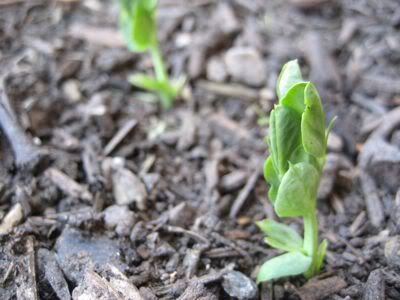
Pisum sativum: At Territorial, peas are of special value to us. Our region of the country is well adapted to growing peas, and many of the nation's most popular pea varieties, such as Oregon Sugar Pod II, were developed at Oregon State University. At our research farm, we conduct extensive trials to identify the best tasting and most productive offerings for shelling, snap, and edible pod peas.
CULTURE: A cool-season crop, peas will grow in a variety of soils provided the soil is well drained, in full sun, and contains a sufficient amount of organic matter to allow for good moisture retention. Peas may be sown as soon as the soil can be worked in the spring. They may be planted without rototilling by scratching out a shallow furrow and covering the seed. Sow seeds 1 inch apart, 1-1 1/2 inches deep, in rows 18-24 inches apart. Thinning is not necessary. Optimum soil temperature for germination: 45-75°F. Days to emergence: 6-14. Coat the seed with an inoculant to increase yields. Inoculant enhances early nitrogen-fixing bacterial nodes on the plant roots. Thinning is not necessary. Side dress plants with one cup of our complete fertilizer per 5 row feet along with 1 cup of bone meal per 10 row feet to foster healthy plants for a bountiful harvest. Climbing varieties must be trellised or planted by a fence. New pole-pea varieties in the US are in decline; the new developments are primarily bush types, which are suitable for mechanical harvest. Most bush-type vines can be supported on a short trellis or allowed to grow as a mound. Stress, such as prolonged hot weather or lack of moisture, will cause a higher percentage of off-type plants and reduced yields. We recommend mulching the roots and frequent ground watering (vs. overhead watering) to help keep the roots cool and productive.
DISEASES: Fusarium wilt (also called pea root rot) causes plant foliage to turn brown from the ground up. This can generally be controlled by crop rotation and sowing on well-drained ground. Choosing resistant varieties and ground watering can control powdery and downy mildews. Areas in the Northwest and Northeast are also prone to attacks of pea enation virus, which is spread by the peach aphids that hatch each summer. The virus causes 'windowing' or a mosaic appearance in the leaves, distortion of the pods, and reduced yields. If pea enation is a problem in your garden, we advise sowing enation-resistant varieties. The best control measures are using disease-free seed, selecting disease-resistant cultivars, and practicing crop rotation.
INSECTS: The pea aphid can be a destructive pea insect pest throughout the summer. Applications of Rotenone or Rotenone-Pyrethrin should be started at the seedling stage if leaf scalloping is observed.
HARVEST: Start checking for maturity as soon as the pods begin to swell. If left on the vine too long, the peas become starchy and the pods become tough. Most bush varieties are bred to mature all at the same time for a concentrated, once-over picking. Extend your harvest through multiple sowings. Store peas at 32°F and at 95% relative humidity.
Pea vine tendrils are an important ingredient in stir-fries, Asian salads, and garnishes. Market gardeners pick the top 6-8 inches of pea vines (tendrils) and sell them in bunches. Cascadia, Oregon Giant and Oregon Sugar Pod II were the favorites in trials conducted at Washington State University Extension.
SEED SPECS: Minimum germination standard: 80%. Days to maturity are calculated from the date of direct seeding. Usual seed life: 2 years. Approximately 90-165 seeds per ounce (average 125); 8 ounces per 1/2 pound
----------
WHEN TO PLANT: You can sow early, mid-season, and late varieties on the same day, or make successive plantings of pea seeds throughout the cool weeks of early spring, but there's no point in sowing most kinds of peas later than two to three weeks before the frost free date, because the yield of peas maturing in warm weather seldom justifies the space they take. Young plants grow best at 59°F to 68°F. An exception is Wando, a good pea for those who must wait in the spring until their community gardens have been plowed.
For fall peas, plant seeds in later July or early August. Mature pea plants are more easily killed by frost than the hardier seedlings.
To put peas on your table, you must get them in the ground early and to do that you often need to prepare the row in the fall. Some gardeners even plant pea seeds in late fall or during a Feb. thaw. However, although it's safe to plant peas in cold soil, because they can sprout at temperatures as low as 40°F - though it could take them a month to do so - it's not wise to work in the garden while the earth is still heavily sodden. We get around this, here in our garden, by doing a late fall plowing, burying all the mulch and leaves and leaving rough mounds. Frost action pulverizes that exposed soil over the winter, and I find that I can usually get out there with a hoe in early March and pull open a furrow of fairly loose soil, going along the top of a ridge left by the plow, not in the deeper, colder valley between the ridges.
HOW TO PLANT: Shake some garden legume inoculant on the moistened seeds before planting. Plant peas thickly, about one every inch, and cover the seeds with 1- 1.5" of soil. Double rows of peas, spaced about 4-6" apart, make more efficient use of soil space then single rows. Wide rows of peas, up to 3' or so, are even more efficient. At one time, I thinned my peas to stand 2-4" apart, but since I've found that slight crowding doesn't seem to reduce production, I've stopped thinning them. Peas don't transplant well.
GROWING CONDITIONS: Pea roots are weak and small, easily dislodged in weeding, so I usually let some weeds grow, close to the plants, to prevent root damage and also to help share the pea roots, which prefer cooler growing weather. They also need plenty of oxygen, so plants grown in compacted or waterlogged soil will not produce as well as those in well aerated ground. Peas also prefer soil that is not highly acidic. They are fairly drought tolerant until flowering, when their moisture needs increase to an inch a week. The first peas appear about three weeks after blossoming.
STAKING: Except for leafless kinds like Novella, which is pretty much self supporting when grown in a triple row, your peas will need some support, even the low growing ones. Cuttings of brush that have lots of twigs are excellent for all kinds of peas and the best choice for wide rows. For tall growing vines like Sugar Snap and Mammoth Melting Sugar, grown in single rows, I supplement the brush with binder twine strung the length of the row between three steep polls. Netting, chicken wire, garden fencing and string supported by stakes are also successfully used by many gardeners.
More info on growing peas
----------
PURCHASED: 1oz from Territorial Seed Co. Jan '09. $1.85
DIRECT SEEDED: 03/13/09, inoculated and direct seeded. Sprouted on 03/29/09. 16 days - seemed like forever! 04/07/09: Only about 1/4 of the seeds I planted sprouted. I dug up the duds to see what was going on - looks like they turned to rotten mush. We've had quite a bit of rain since I planted them. The good news is now I'll have a staggered planting for a staggered harvest. I'll go and replace the one's that haven't come up later this week. Reseeded on 04/10/09.
DISEASE ISSUES:
INSECT ISSUES:
HARVEST YEILD & DURATION:
OTHER NOTES:
3/30/09

04/06/09

Salad Bowl & Mascara Lettuce
Salad Bowl Lettuce
50 days. We've offered Salad Bowl for years because gardeners still love its wonderful mellow flavor. This one is a prime candidate for early spring sowings in a cold frame or even unprotected in the garden. Grows very rapidly for early spring salads and resists bolting when summer arrives. Frilly, deeply cut leaves frame large, lime-green rosettes. OP
Mascara Lettuce
Organic. 48 days. A very uniform, dark red oak leaf type. It is the standard that all red oaks must go up against, and it's hard to beat. In trials, Mascara retains its color during the hottest parts of the summer, when others tend to fade. Combines well with regular green leaf types to make beautiful mid-summer salads. Very bolt resistant; mild, non-bitter flavor. OP
Lactuca sativa: The purpose of our ongoing lettuce evaluations and seed productions is to enable the home gardener to grow tasty salads year-round with minimal effort. By utilizing different varieties of lettuces and different cultural practices, a fresh salad is never farther away than your garden.
CULTURE: Most lettuces are hardy, cool-season crops that can be planted as early as the soil can be worked. Many do best when the air temperature is between 60-70°F, and will germinate well at soil temperatures as low as 40°F. Choose heat tolerant varieties for summer plantings. Lettuce can be sown either directly into the garden or started indoors and transplanted. With succession plantings every 3 weeks, you can enjoy fresh salads all season. A cold frame and cold-hardy varieties can stretch the spring and fall growing season into the winter months. Optimum soil temperature range for germination: 40-75°F. Days to emergence: 2-15.
TO DIRECT SOW: Sow seed 1/4-1/2 inch deep, 1 inch apart, in rows 16-18 inches apart. Cover seeds lightly and firm gently. As soon as 2-3 true leaves have formed, thin loose-leaf types 10-14 inches apart and icebergs, bibbs, and romaines 12-16 inches apart.
FOR TRANSPLANTS: Sow 3-4 seeds per inch in sterile seedling mix 3 weeks prior to planting out. Transplant individual plants into pots or cell trays 2 weeks after sowing. Before planting outside, harden off for 2-3 days by reducing water and placing outdoors in a sheltered location. Leafy green vegetables require a moderately fertile soil. One cup of our complete fertilizer per 10 row feet will provide adequate nutrition.
INSECTS/PESTS: Most lettuce grows quickly, so pests aren't a problem. Aphids can be washed off with a strong spray of water, and slugs can be controlled with diatomaceous earth, slug baits, or traps.
HARVEST: During the warmer seasons, lettuce remains in prime eating condition for about 3 weeks. While picking individual leaves helps extend the season somewhat, all eventually become tough and bitter as they begin to bolt. We've found that rinsing lettuce under warm tap water can help reduce bitterness.
SEED SPECS: Minimum germination standard: 80%. Usual seed life: 3 years. Sampler will sow 15 row feet. Approximately 800 seeds per gram; 28 grams per ounce.
----------
WHEN TO PLANT: Loose leaf lettuce (Lactuca sativa var. crispa) grows so quickly in the cool days of early spring that few gardeners start it early indoors, although if you have a the space to do so, you can beat the season by a week or so or up to a month if you set plants out under protective cloches or tunnels. Plant seeds of leaf lettuce as soon as the ground can be worked. Romaine and butterhead types, which mature a bit later, may be either started indoors or direct seeded.
HOW TO PLANT: Plant seeds no more than 1/4" deep. Although lettuce seeds you sow indoors usually germinate within a week, early outdoor plantings in cold soil my not come up for two weeks. Thin the plants to 3" apart. In another two or three weeks, I pull alternate plants for salad, letting the rest, now spaced 6" apart, grow to soft head or full leaf size.
GROWING CONDITIONS: Lettuce plants will bolt once they're fully developed, not matter what you do, but heat and long days can hasten bolting. Mulch to keep the soil cool and try to shield plants from light at night, such as that from yard and porch lights.
SUMMER PLANTING: Since lettuce doesn't keep and can't be canned, plant short rows or blocks every two or three weeks all season, using one of the slower bolting kinds like Anuenue, Orfeo or Little Gem for summer plantings. One experienced gardener says, "Plant 10 lettuce seeds a week". I've read that you can even scatter seeds on bare ground during a winter thaw for record early May lettuce. I haven't tried this yet but it makes sense, because volunteer lettuces usually appear quite early.
Summer heat sometimes sends lettuce seeds into dormncy. To get around this, and raise the lettuce to go with your tomatoes, you can expose the germinating seeds to light, refrigerate the seeds for a week or two before planting , or use old seeds, which are less likely to maintain dormancy in hot weather.
----------
SALAD BOWL
PURCHASED: 1g from Territorial Seed Co. Jan '09. $2.35
STARTED SEED: 2/5/09, 9 pm - one batch with heating mat (82° - consistent) one without (72° / next morning 62°). Seeds germinated much better in the cooler flat maybe 80% or so. The hotter mat had a rate of about 20% or less! Though both were showing signs of life by 2/7 - 2 days - not bad! Salad Bowl sprouted about 10 hours before Mascara.
HARDENED OFF: 3/15/09: One hour in the cold frame. Added an hour each day for a week or so till finally I left them out over night in the cold frame. Planted in the garden the next day.
TRANSPLANTED IN GARDEN:
DISEASE ISSUES:
INSECT ISSUES: 3/27/09: Noticed that something ate one of the starts to the quick. Will investigate this evening.
HARVEST YEILD & DURATION:
OTHER NOTES:
2/8/09

2/23/09

03/02/09
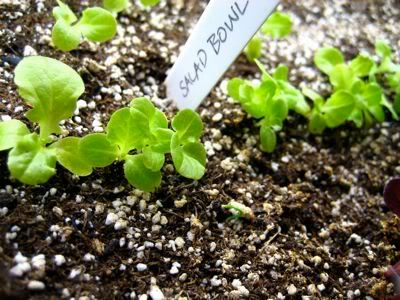
03/16/09
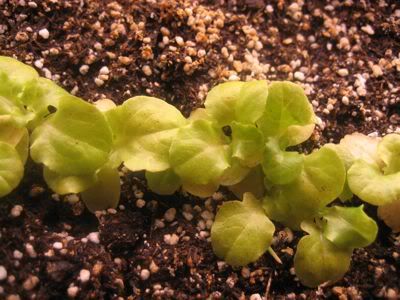
03/23/09
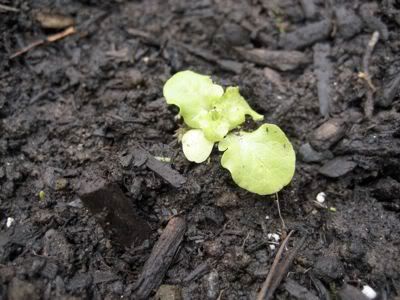
03/30/09

MASCARA
PURCHASED: 1/2g from Territorial Seed Co. Jan '09. $2.85
STARTED SEED: 2/5/09, 9 pm - one batch with heating mat (82° - consistent) one without (72° / next morning 62°). Seeds germinated much better in the cooler flat maybe 80% or so. The hotter mat had a rate of about 20% or less! Though both were showing signs of life by 2/7 - 2 days - not bad! Salad Bowl sprouted about 10 hours before Mascara.
HARDENED OFF: 3/15/09: One hour in the cold frame.
TRANSPLANTED IN GARDEN:
DISEASE ISSUES:
INSECT ISSUES:
HARVEST YEILD & DURATION:
OTHER NOTES:
2/23/09

03/02/09
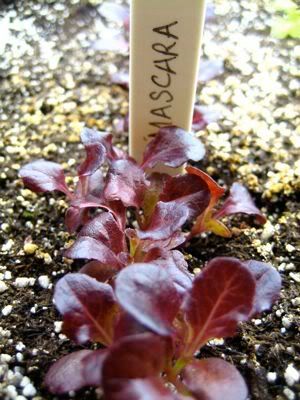
03/16/09
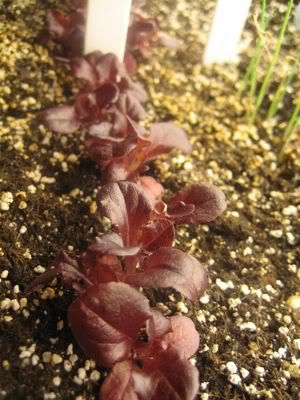
03/23/09
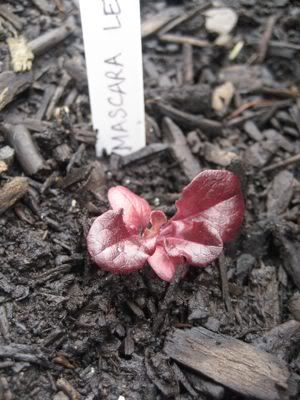
03/30/09
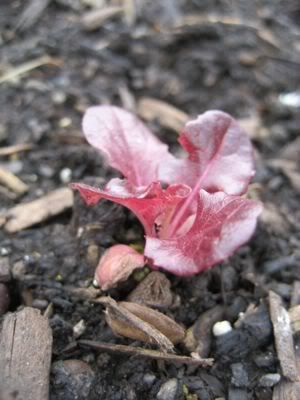
50 days. We've offered Salad Bowl for years because gardeners still love its wonderful mellow flavor. This one is a prime candidate for early spring sowings in a cold frame or even unprotected in the garden. Grows very rapidly for early spring salads and resists bolting when summer arrives. Frilly, deeply cut leaves frame large, lime-green rosettes. OP
Mascara Lettuce
Organic. 48 days. A very uniform, dark red oak leaf type. It is the standard that all red oaks must go up against, and it's hard to beat. In trials, Mascara retains its color during the hottest parts of the summer, when others tend to fade. Combines well with regular green leaf types to make beautiful mid-summer salads. Very bolt resistant; mild, non-bitter flavor. OP
Lactuca sativa: The purpose of our ongoing lettuce evaluations and seed productions is to enable the home gardener to grow tasty salads year-round with minimal effort. By utilizing different varieties of lettuces and different cultural practices, a fresh salad is never farther away than your garden.
CULTURE: Most lettuces are hardy, cool-season crops that can be planted as early as the soil can be worked. Many do best when the air temperature is between 60-70°F, and will germinate well at soil temperatures as low as 40°F. Choose heat tolerant varieties for summer plantings. Lettuce can be sown either directly into the garden or started indoors and transplanted. With succession plantings every 3 weeks, you can enjoy fresh salads all season. A cold frame and cold-hardy varieties can stretch the spring and fall growing season into the winter months. Optimum soil temperature range for germination: 40-75°F. Days to emergence: 2-15.
TO DIRECT SOW: Sow seed 1/4-1/2 inch deep, 1 inch apart, in rows 16-18 inches apart. Cover seeds lightly and firm gently. As soon as 2-3 true leaves have formed, thin loose-leaf types 10-14 inches apart and icebergs, bibbs, and romaines 12-16 inches apart.
FOR TRANSPLANTS: Sow 3-4 seeds per inch in sterile seedling mix 3 weeks prior to planting out. Transplant individual plants into pots or cell trays 2 weeks after sowing. Before planting outside, harden off for 2-3 days by reducing water and placing outdoors in a sheltered location. Leafy green vegetables require a moderately fertile soil. One cup of our complete fertilizer per 10 row feet will provide adequate nutrition.
INSECTS/PESTS: Most lettuce grows quickly, so pests aren't a problem. Aphids can be washed off with a strong spray of water, and slugs can be controlled with diatomaceous earth, slug baits, or traps.
HARVEST: During the warmer seasons, lettuce remains in prime eating condition for about 3 weeks. While picking individual leaves helps extend the season somewhat, all eventually become tough and bitter as they begin to bolt. We've found that rinsing lettuce under warm tap water can help reduce bitterness.
SEED SPECS: Minimum germination standard: 80%. Usual seed life: 3 years. Sampler will sow 15 row feet. Approximately 800 seeds per gram; 28 grams per ounce.
----------
WHEN TO PLANT: Loose leaf lettuce (Lactuca sativa var. crispa) grows so quickly in the cool days of early spring that few gardeners start it early indoors, although if you have a the space to do so, you can beat the season by a week or so or up to a month if you set plants out under protective cloches or tunnels. Plant seeds of leaf lettuce as soon as the ground can be worked. Romaine and butterhead types, which mature a bit later, may be either started indoors or direct seeded.
HOW TO PLANT: Plant seeds no more than 1/4" deep. Although lettuce seeds you sow indoors usually germinate within a week, early outdoor plantings in cold soil my not come up for two weeks. Thin the plants to 3" apart. In another two or three weeks, I pull alternate plants for salad, letting the rest, now spaced 6" apart, grow to soft head or full leaf size.
GROWING CONDITIONS: Lettuce plants will bolt once they're fully developed, not matter what you do, but heat and long days can hasten bolting. Mulch to keep the soil cool and try to shield plants from light at night, such as that from yard and porch lights.
SUMMER PLANTING: Since lettuce doesn't keep and can't be canned, plant short rows or blocks every two or three weeks all season, using one of the slower bolting kinds like Anuenue, Orfeo or Little Gem for summer plantings. One experienced gardener says, "Plant 10 lettuce seeds a week". I've read that you can even scatter seeds on bare ground during a winter thaw for record early May lettuce. I haven't tried this yet but it makes sense, because volunteer lettuces usually appear quite early.
Summer heat sometimes sends lettuce seeds into dormncy. To get around this, and raise the lettuce to go with your tomatoes, you can expose the germinating seeds to light, refrigerate the seeds for a week or two before planting , or use old seeds, which are less likely to maintain dormancy in hot weather.
----------
SALAD BOWL
PURCHASED: 1g from Territorial Seed Co. Jan '09. $2.35
STARTED SEED: 2/5/09, 9 pm - one batch with heating mat (82° - consistent) one without (72° / next morning 62°). Seeds germinated much better in the cooler flat maybe 80% or so. The hotter mat had a rate of about 20% or less! Though both were showing signs of life by 2/7 - 2 days - not bad! Salad Bowl sprouted about 10 hours before Mascara.
HARDENED OFF: 3/15/09: One hour in the cold frame. Added an hour each day for a week or so till finally I left them out over night in the cold frame. Planted in the garden the next day.
TRANSPLANTED IN GARDEN:
DISEASE ISSUES:
INSECT ISSUES: 3/27/09: Noticed that something ate one of the starts to the quick. Will investigate this evening.
HARVEST YEILD & DURATION:
OTHER NOTES:
2/8/09

2/23/09

03/02/09

03/16/09

03/23/09

03/30/09

MASCARA
PURCHASED: 1/2g from Territorial Seed Co. Jan '09. $2.85
STARTED SEED: 2/5/09, 9 pm - one batch with heating mat (82° - consistent) one without (72° / next morning 62°). Seeds germinated much better in the cooler flat maybe 80% or so. The hotter mat had a rate of about 20% or less! Though both were showing signs of life by 2/7 - 2 days - not bad! Salad Bowl sprouted about 10 hours before Mascara.
HARDENED OFF: 3/15/09: One hour in the cold frame.
TRANSPLANTED IN GARDEN:
DISEASE ISSUES:
INSECT ISSUES:
HARVEST YEILD & DURATION:
OTHER NOTES:
2/23/09

03/02/09

03/16/09

03/23/09

03/30/09

Shelton Leek
110 days. Warm autumn meals beg for the sumptuous, savory, heartiness of leeks. With Shelton, you can grace your holiday or everyday fall dishes with fresh leeks right from the garden. Immaculate, straight, white roots and deep green, robust foliage make this variety a cinch to clean. Upright, sturdy plants hold well in the field. Hybrid Variety.
Allium ampeloprasum: Leek cultivation dates back hundreds of years to southern Europe. Today the leek serves as an excellent substitute for onions and can be grown in protected gardens well into the fall.
CULTURE: Leeks are a cool-season biennial grown as an annual. They are well worth the effort because they are frost hardy and can supply the gardener with fresh onions all winter and well into spring. They thrive in well composted, well worked, and well drained soil. Leeks can be started as transplants or direct sown in the garden if you have optimum soil conditions. Transplants will yield larger plants by autumn.
FOR TRANSPLANTS: Begin 8-10 weeks before your last frost. Sow 4 seeds per inch, 1/4-1/2 inch deep in rows 3 inches apart in your tray. Optimum soil temperature for germination: 55-75°F. Days to emergence: 8-16 days. Thin seedlings to 1/2 inch apart in the row. For stockier plants, keep the tops trimmed to 3 inches. Transplant into the garden after the threat of frost and the soil can be worked to a depth of 8-10 inches. Dig a trench 6-8 inches deep and wide. Each row should be 12-18 inches apart. Work in 1/4-1/2 cup of our complete fertilizer per 5 row feet. Place seedlings 4-5 inches apart in the bottom of the trench. Blanch to increase the length of white stem by gradually filling in the trench as the leeks grow.
DIRECT SEEDING: After your last frost, direct sow seeds 1/4-1/2 inch deep in rows 12-18 inches apart. Cover with vermiculite or sifted compost. Thin plants to 4-5 inches apart.
HARVEST: Dig anytime the leeks are 1/2 inch in diameter or larger. Can be used raw or cooked. Store at 33°F and 65% relative humidity.
INSECTS/PESTS: Seldom a problem.
DISEASE: Very resistant.
SEED SPECS: Minimum germination standard: 70%. Usual seed life: 1 year. Days to maturity are calculated from date of transplant. Approximately 175 seeds per 1/2 gram, about 350 seeds per gram; 14 grams per 1/2 ounce. A sampler will sow 25 feet.
----------
WHEN TO PLANT: I plant the seeds in flats in February, and thin the seedlings to stand no closer then 1" apart in the flat. Plant them out in April or May or direct seed in the ground in April, preferably in a nursery bed to save space. Leeks need a long growing season but will accept a variety of growing conditions. Where winters are mild, leeks can be planted in the fall for a winter crop.
HOW TO PLANT: Plant the seedlings in a trench 6" wide x 6" deep. When the plants are 6-8" high, gradually hoe find soil from the sides of the trench to fill the space. Do this every three weeks or so, adding an inch of soil to the trench each time. Always keep the soil level at or just below the point where the leaves diverge from the stem. Leeks are biennials, and those that take longer to mature will usually keep well into winter if hilled up with soil or mulched.
GROWING CONDITIONS: They do respond well to plenty of humus and steady moisture and their extensive roots appreciate deeply dug soil. Leeks left in the ground over winter will form corms - tiny bulbs - around the base in late spring. You can plant these corms for an easy second year crop of this tasty vegetable.
----------
PURCHASED: 1/8g from Territorial Seed Co. Jan '09. $3.45
STARTED SEED: 2/5/09, 9 pm - one batch with heating mat (82° - consistent) one without (72° / next morning 62°). The unheated tray showed its first sprout on 2/11 - 6 days!
HARDENED OFF: 3/15/09: One hour in the cold frame.
TRANSPLANTED IN GARDEN:
DISEASE ISSUES:
INSECT ISSUES:
HARVEST YEILD & DURATION:
OTHER NOTES:
03/02/09

03/16/09
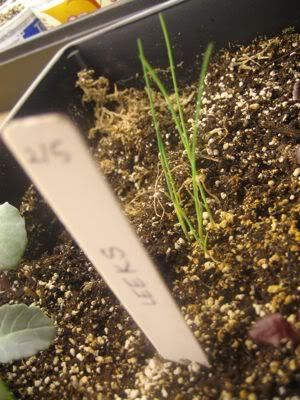
03/30/09
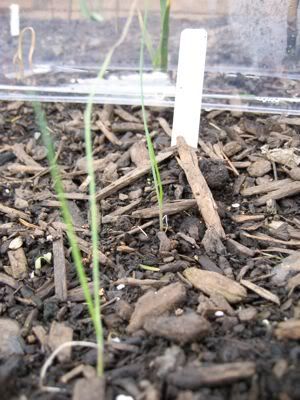
Allium ampeloprasum: Leek cultivation dates back hundreds of years to southern Europe. Today the leek serves as an excellent substitute for onions and can be grown in protected gardens well into the fall.
CULTURE: Leeks are a cool-season biennial grown as an annual. They are well worth the effort because they are frost hardy and can supply the gardener with fresh onions all winter and well into spring. They thrive in well composted, well worked, and well drained soil. Leeks can be started as transplants or direct sown in the garden if you have optimum soil conditions. Transplants will yield larger plants by autumn.
FOR TRANSPLANTS: Begin 8-10 weeks before your last frost. Sow 4 seeds per inch, 1/4-1/2 inch deep in rows 3 inches apart in your tray. Optimum soil temperature for germination: 55-75°F. Days to emergence: 8-16 days. Thin seedlings to 1/2 inch apart in the row. For stockier plants, keep the tops trimmed to 3 inches. Transplant into the garden after the threat of frost and the soil can be worked to a depth of 8-10 inches. Dig a trench 6-8 inches deep and wide. Each row should be 12-18 inches apart. Work in 1/4-1/2 cup of our complete fertilizer per 5 row feet. Place seedlings 4-5 inches apart in the bottom of the trench. Blanch to increase the length of white stem by gradually filling in the trench as the leeks grow.
DIRECT SEEDING: After your last frost, direct sow seeds 1/4-1/2 inch deep in rows 12-18 inches apart. Cover with vermiculite or sifted compost. Thin plants to 4-5 inches apart.
HARVEST: Dig anytime the leeks are 1/2 inch in diameter or larger. Can be used raw or cooked. Store at 33°F and 65% relative humidity.
INSECTS/PESTS: Seldom a problem.
DISEASE: Very resistant.
SEED SPECS: Minimum germination standard: 70%. Usual seed life: 1 year. Days to maturity are calculated from date of transplant. Approximately 175 seeds per 1/2 gram, about 350 seeds per gram; 14 grams per 1/2 ounce. A sampler will sow 25 feet.
----------
WHEN TO PLANT: I plant the seeds in flats in February, and thin the seedlings to stand no closer then 1" apart in the flat. Plant them out in April or May or direct seed in the ground in April, preferably in a nursery bed to save space. Leeks need a long growing season but will accept a variety of growing conditions. Where winters are mild, leeks can be planted in the fall for a winter crop.
HOW TO PLANT: Plant the seedlings in a trench 6" wide x 6" deep. When the plants are 6-8" high, gradually hoe find soil from the sides of the trench to fill the space. Do this every three weeks or so, adding an inch of soil to the trench each time. Always keep the soil level at or just below the point where the leaves diverge from the stem. Leeks are biennials, and those that take longer to mature will usually keep well into winter if hilled up with soil or mulched.
GROWING CONDITIONS: They do respond well to plenty of humus and steady moisture and their extensive roots appreciate deeply dug soil. Leeks left in the ground over winter will form corms - tiny bulbs - around the base in late spring. You can plant these corms for an easy second year crop of this tasty vegetable.
----------
PURCHASED: 1/8g from Territorial Seed Co. Jan '09. $3.45
STARTED SEED: 2/5/09, 9 pm - one batch with heating mat (82° - consistent) one without (72° / next morning 62°). The unheated tray showed its first sprout on 2/11 - 6 days!
HARDENED OFF: 3/15/09: One hour in the cold frame.
TRANSPLANTED IN GARDEN:
DISEASE ISSUES:
INSECT ISSUES:
HARVEST YEILD & DURATION:
OTHER NOTES:
03/02/09

03/16/09

03/30/09

Labels:
110 days,
Eatable Plant List,
HV,
kitchen garden,
Leeks,
Territorial Seed Co.
Giant Red Celery
85-95 days. Giant Red is an heirloom variety that brings back the real taste of celery. A wonderful celery to use in making soups and stews. The stalks are 10-15 inches long and maintain their quality in the garden moderately well. After harvest they will keep in a plastic bag for about 2 weeks in your refrigerator. Interior stalks reveal just a blush of red to accent your salad or relish tray.
Apium graveolens var dulce: First grown as an herb and as a flavoring, celery is now eaten in 3 main forms: celery leaf, sometimes called soup celery; the swollen leaf petiol which is the familiar celery stick form; and the swollen rootstock we know as celeriac Apium graveolens var. rapaceum. Celery is 94% water, which makes it a great diet food. Some dieters claim that chewing celery uses more calories than the stalks contain.
CULTURE: The most successful crops are grown for fall harvest rather than mid-summer harvest. Weather fluctuations and cold nights cause celery to bolt. Sow 1/8 inch deep in sterile seedling mix indoors February through April. Keep soil moist. Days to emergence: 10-20. When raising transplants, you must keep soil temperatures above 55°F and below 70°F. This is vital to success. Transplant 12 inches apart in rows at least 18 inches apart when the weather is warm enough for peppers and melons. Celery is one of the heaviest feeding plants grown in the garden. Apply 1 1/2-2 cups of our complete fertilizer into the soil per 5 row feet to provide adequate nutrition. Also keep well watered; the small-diameter roots grow deeply, adapted to draw large amounts of water from wet, boggy places. Bolting is the result of young plants being exposed to nighttime air temperatures below 55°F for a week or more. Direct sowing is not recommended.
DISEASE: Good preventive measures include crop rotation, adequate water supply, and aphid control.
INSECTS/PESTS: The larva of the carrot fly is an occasional celery pest. Mature larva are 3/8 inch long, straw-colored, and wiry. Worms burrow into the heart and kill or stunt the plant. Crop row covers such as Reemay, Grow Guard 20, or Summer Insect Barrier are very effective deterrents.
HARVEST: In mild climates, celery and celeriac can be overwintered in the ground. Chopping off the entire head is not advisable. Instead, pick individual stalks as needed. In spring, the unopened flowers and the tender stalks below them are particularly good tasting. Where winters are severe, the plants must be dug and stored in a root cellar.
SEED SPECS: Minimum germination standard: 65%. Days to maturity calculated from date of transplant; add 60 days if direct seeding. Usual seed life: 3 years. Approximately 1000 seeds per 1/2 gram; 1/4 ounce is 7 grams.
----------
WHEN TO PLANT: Celery maybe planted indoors in February or March and set out about two weeks after the last expected frost or sown in April or May for a fall crop. Germination is fairly slow - about three weeks. Celery does best in cool weather, so the fall crop is often the best. Celery germinates best at 60°F to 70°F.
HOW TO PLANT: If temperature at planting time is unfavorably high, exposure to light will help to stimulate germination. Alternating temperatures (warmer by day, cooler by night) also helps. At the preferred lower temperature, light doesn't seem to make any difference. Keep the soil evenly moist during germination. When hardening off, avoid chilling the plant below 50°F or it may bolt to seed. Celery has a skimpy root system and transplants well as long as the job is done early, when the seedlings are 3-5" high, before a tap root forms.
GROWING CONDITIONS: Because celery's ancestors were marsh dwellers, it needs a steady and plentiful supply of moisture, more then most other garden vegetables but drainage should be good. Try sinking bottomless cans between plants, which should be planted 8-10" apart and filling the cans with water from the hose. Celery is a heavy feeder too, so put compost in the planting hole and give plants extra feeding of manure tea or fish emulsion about twice a month.
----------
PURCHASED: 1/2g from Territorial Seed Co. Jan '09. $2.15
STARTED SEED: With our weather I'm not sure if this crop will do best as a spring or fall so I'll try a little of both. Started my spring seeds on 02/23/09. Sprouted on 03/03/09 - 8 days to germinate.
HARDENED OFF:
TRANSPLANTED IN GARDEN:
DISEASE ISSUES:
INSECT ISSUES:
HARVEST YEILD & DURATION:
OTHER NOTES:
03/16/09

03/23/09

Apium graveolens var dulce: First grown as an herb and as a flavoring, celery is now eaten in 3 main forms: celery leaf, sometimes called soup celery; the swollen leaf petiol which is the familiar celery stick form; and the swollen rootstock we know as celeriac Apium graveolens var. rapaceum. Celery is 94% water, which makes it a great diet food. Some dieters claim that chewing celery uses more calories than the stalks contain.
CULTURE: The most successful crops are grown for fall harvest rather than mid-summer harvest. Weather fluctuations and cold nights cause celery to bolt. Sow 1/8 inch deep in sterile seedling mix indoors February through April. Keep soil moist. Days to emergence: 10-20. When raising transplants, you must keep soil temperatures above 55°F and below 70°F. This is vital to success. Transplant 12 inches apart in rows at least 18 inches apart when the weather is warm enough for peppers and melons. Celery is one of the heaviest feeding plants grown in the garden. Apply 1 1/2-2 cups of our complete fertilizer into the soil per 5 row feet to provide adequate nutrition. Also keep well watered; the small-diameter roots grow deeply, adapted to draw large amounts of water from wet, boggy places. Bolting is the result of young plants being exposed to nighttime air temperatures below 55°F for a week or more. Direct sowing is not recommended.
DISEASE: Good preventive measures include crop rotation, adequate water supply, and aphid control.
INSECTS/PESTS: The larva of the carrot fly is an occasional celery pest. Mature larva are 3/8 inch long, straw-colored, and wiry. Worms burrow into the heart and kill or stunt the plant. Crop row covers such as Reemay, Grow Guard 20, or Summer Insect Barrier are very effective deterrents.
HARVEST: In mild climates, celery and celeriac can be overwintered in the ground. Chopping off the entire head is not advisable. Instead, pick individual stalks as needed. In spring, the unopened flowers and the tender stalks below them are particularly good tasting. Where winters are severe, the plants must be dug and stored in a root cellar.
SEED SPECS: Minimum germination standard: 65%. Days to maturity calculated from date of transplant; add 60 days if direct seeding. Usual seed life: 3 years. Approximately 1000 seeds per 1/2 gram; 1/4 ounce is 7 grams.
----------
WHEN TO PLANT: Celery maybe planted indoors in February or March and set out about two weeks after the last expected frost or sown in April or May for a fall crop. Germination is fairly slow - about three weeks. Celery does best in cool weather, so the fall crop is often the best. Celery germinates best at 60°F to 70°F.
HOW TO PLANT: If temperature at planting time is unfavorably high, exposure to light will help to stimulate germination. Alternating temperatures (warmer by day, cooler by night) also helps. At the preferred lower temperature, light doesn't seem to make any difference. Keep the soil evenly moist during germination. When hardening off, avoid chilling the plant below 50°F or it may bolt to seed. Celery has a skimpy root system and transplants well as long as the job is done early, when the seedlings are 3-5" high, before a tap root forms.
GROWING CONDITIONS: Because celery's ancestors were marsh dwellers, it needs a steady and plentiful supply of moisture, more then most other garden vegetables but drainage should be good. Try sinking bottomless cans between plants, which should be planted 8-10" apart and filling the cans with water from the hose. Celery is a heavy feeder too, so put compost in the planting hole and give plants extra feeding of manure tea or fish emulsion about twice a month.
----------
PURCHASED: 1/2g from Territorial Seed Co. Jan '09. $2.15
STARTED SEED: With our weather I'm not sure if this crop will do best as a spring or fall so I'll try a little of both. Started my spring seeds on 02/23/09. Sprouted on 03/03/09 - 8 days to germinate.
HARDENED OFF:
TRANSPLANTED IN GARDEN:
DISEASE ISSUES:
INSECT ISSUES:
HARVEST YEILD & DURATION:
OTHER NOTES:
03/16/09

03/23/09

Labels:
85-95 days,
Celery,
Eatable Plant List,
Fall Crop,
kitchen garden,
OP,
Territorial Seed Co.
Fortex Bean
70 days. An early and productive gourmet delight. The exceptionally long, medium-green pods grow to over 10 inches long. This stringless French pole bean can be harvested at 6-7 inches for extra slender filet beans. Scrumptious when fresh, the rich, sweet flavor is a welcome treat. Fine restaurant or specialty market farmers should grow this one. The 6 foot tall vigorous plants require trellising. Dark brown seeds. Resistant to Anthracnose and Bean Common Mosaic Viruses. OP.
"These refined French/filet beans, or haricots verts, are harvested at less than 1/4 inch in diameter. At this stage these beans are very tender, stringless, and flavorful. For the highest quality beans, harvest frequently during peak production.
CULTURE: For growing information, refer to the Bush Bean culture box. Optimum soil temperature for germination is 65-85°F. Days to emergence: 8-16.
BUSH BEAN CULTURE: Bush beans are one of the most trouble-free garden crops and mature just ahead of pole beans. Beans like warm soil and will not germinate if the soil temperature is below 60°F. Optimum soil temperature range is 65-85°F. You can expect emergence in 8-16 days depending on the variety. In a well worked bed, plant the seeds 2-3 inches apart and 1 inch deep in rows 18-36 inches apart. Thinning is rarely necessary. Beans are relatively light feeders. One cup of our complete fertilizer per 10 row feet will provide adequate nutrition. Excess nitrogen results in excess foliage with poor pod set and delayed maturity. Optimum pH is in the range of 5.5-6.5, mildly acidic. Beans are shallow rooted and can require up to 1/4 inch of water a day during hot weather. Mulch around the roots to help conserve moisture.
DISEASE: Beans are subject to numerous diseases. Avoid wetting the foliage, remove plants at the end of the year, and practice a 4-year crop rotation to prevent potential problems.
INSECTS: Mexican bean beetles and bean weevils can significantly damage young seedlings. To treat, dust them with Rotenone. Optimum soil conditions foster vigorous plants, which can help plant growth outpace insect damage.
HARVEST: Green beans are ready for harvest about 2 weeks after bloom. Pick when the pods are nearly full size and the seeds are still small. Pods at this stage have firm, crispy flesh and are low in fiber content. Keep plants well picked to extend harvest and increase yield. Plant short rows for fresh eating; plant longer rows to have additional beans for canning and freezing. A 20 foot row will feed the average family of 4, unless heavy canning is anticipated.
SEED SPECS: Minimum germination standard: 80%. Usual seed life: 2-3 years. One ounce plants 12-15 row feet, 1/2 pound for 100 row feet; 1/2 pound is 8 ounces. Seed counts are listed in the variety description.
----------
WHEN TO PLANT: Sow seeds (of Phaseolus vulgaris) when all danger of frost is past. An exception, the Royal Burgundy purple bean, can be planted as early as three weeks before the last expected frost, because it is less prone to rot in cold soil. The planting of Royal Burgundy we make in later April usually pays off in beans by the end of June.
Make succession plantings of bush beans, which bear heavily but for a short period of time. Neither the bush nor the pole beans transplant well. I always put in a late planting at then of July to bear in early fall when cools nights have sent the bean beetles on their way.
HOW TO PLANT: Briefly presoak bush bean seeds for an hour or two and plant 2-3" apart in single rows, 4-5" apart in double rows, with 15-24" between rows. Inoculate after soaking.
GROWING CONDITIONS: Beans are sensitive to an excess of potash in the soil, a fact I learned the hard way one year when I planted pole beans in a spot where a big, heavy, wet bag of wood ash had burst and spilled the previous year.
VARIETIES: Pole beans begin to bear somewhat later but continue longer then bush beans. They should be planted in a circle around each pole. about 8 to 10 seeds per pole. Thin them to four or five plants. These taller growing vines should be planted on the north side of the garden to avoid shading other plants.
Scarlet runner beans, which may be eaten when young before they develop strings, accept cooler soil then snap beans and may be planted one to two weeks earlier. Nick and presoak the seeds before planting.
REMARKS:
----------
PURCHASED: 1oz from Territorial Seed Co. Jan '09. $4.20
STARTED SEED:
HARDENED OFF:
TRANSPLANTED IN GARDEN:
DISEASE ISSUES:
INSECT ISSUES:
HARVEST YEILD & DURATION:
OTHER NOTES:
"These refined French/filet beans, or haricots verts, are harvested at less than 1/4 inch in diameter. At this stage these beans are very tender, stringless, and flavorful. For the highest quality beans, harvest frequently during peak production.
CULTURE: For growing information, refer to the Bush Bean culture box. Optimum soil temperature for germination is 65-85°F. Days to emergence: 8-16.
BUSH BEAN CULTURE: Bush beans are one of the most trouble-free garden crops and mature just ahead of pole beans. Beans like warm soil and will not germinate if the soil temperature is below 60°F. Optimum soil temperature range is 65-85°F. You can expect emergence in 8-16 days depending on the variety. In a well worked bed, plant the seeds 2-3 inches apart and 1 inch deep in rows 18-36 inches apart. Thinning is rarely necessary. Beans are relatively light feeders. One cup of our complete fertilizer per 10 row feet will provide adequate nutrition. Excess nitrogen results in excess foliage with poor pod set and delayed maturity. Optimum pH is in the range of 5.5-6.5, mildly acidic. Beans are shallow rooted and can require up to 1/4 inch of water a day during hot weather. Mulch around the roots to help conserve moisture.
DISEASE: Beans are subject to numerous diseases. Avoid wetting the foliage, remove plants at the end of the year, and practice a 4-year crop rotation to prevent potential problems.
INSECTS: Mexican bean beetles and bean weevils can significantly damage young seedlings. To treat, dust them with Rotenone. Optimum soil conditions foster vigorous plants, which can help plant growth outpace insect damage.
HARVEST: Green beans are ready for harvest about 2 weeks after bloom. Pick when the pods are nearly full size and the seeds are still small. Pods at this stage have firm, crispy flesh and are low in fiber content. Keep plants well picked to extend harvest and increase yield. Plant short rows for fresh eating; plant longer rows to have additional beans for canning and freezing. A 20 foot row will feed the average family of 4, unless heavy canning is anticipated.
SEED SPECS: Minimum germination standard: 80%. Usual seed life: 2-3 years. One ounce plants 12-15 row feet, 1/2 pound for 100 row feet; 1/2 pound is 8 ounces. Seed counts are listed in the variety description.
----------
WHEN TO PLANT: Sow seeds (of Phaseolus vulgaris) when all danger of frost is past. An exception, the Royal Burgundy purple bean, can be planted as early as three weeks before the last expected frost, because it is less prone to rot in cold soil. The planting of Royal Burgundy we make in later April usually pays off in beans by the end of June.
Make succession plantings of bush beans, which bear heavily but for a short period of time. Neither the bush nor the pole beans transplant well. I always put in a late planting at then of July to bear in early fall when cools nights have sent the bean beetles on their way.
HOW TO PLANT: Briefly presoak bush bean seeds for an hour or two and plant 2-3" apart in single rows, 4-5" apart in double rows, with 15-24" between rows. Inoculate after soaking.
GROWING CONDITIONS: Beans are sensitive to an excess of potash in the soil, a fact I learned the hard way one year when I planted pole beans in a spot where a big, heavy, wet bag of wood ash had burst and spilled the previous year.
VARIETIES: Pole beans begin to bear somewhat later but continue longer then bush beans. They should be planted in a circle around each pole. about 8 to 10 seeds per pole. Thin them to four or five plants. These taller growing vines should be planted on the north side of the garden to avoid shading other plants.
Scarlet runner beans, which may be eaten when young before they develop strings, accept cooler soil then snap beans and may be planted one to two weeks earlier. Nick and presoak the seeds before planting.
REMARKS:
----------
PURCHASED: 1oz from Territorial Seed Co. Jan '09. $4.20
STARTED SEED:
HARDENED OFF:
TRANSPLANTED IN GARDEN:
DISEASE ISSUES:
INSECT ISSUES:
HARVEST YEILD & DURATION:
OTHER NOTES:
Imperial Star Artichoke
This artichoke is for gardeners who can't overwinter artichokes or just want to grow them as an annual. The 6-8 buds of Imperial Star are nearly spineless, up to 3-4 inches in diameter, globe-shaped, and a rich glossy green. Imperial Star has the same rich flavor as our old favorite Green Globe. Will perennialize in areas above zone 7. Plant Variety Protected. OP
"Cynara scolymus: Introduced into California in the 1920's by Italian farmers, the artichoke has since become a chosen favorite of gourmet gardeners on this continent.
CULTURE: Artichokes and cardoon appreciate conditions that foster rapid growth. Start indoors in late January or early February; sow seeds 1/4 inch deep in 4 inch pots filled with sterile seedling mix. When the soil temperature is maintained between 50-75°F, emergence occurs in 10-20 days. Sow heavily and expect 70% germination. Of these seedlings, about 20% will not produce high quality plants. Cull out the small and albino plants. Fertilize transplants with a good all purpose liquid fertilizer such as Earth Juice Grow 2-1-1. Transplant after the danger of frost has passed, but when the seedlings can still receive 10-12 days of temperatures under 50°F, which induces earlier budding. The period of cool temperatures needed to stimulate growth and flowering varies with location and variety. Space transplants 24 inches apart in rows 3 feet apart. Work in 1 cup of our complete fertilizer or a shovelful of composted chicken manure per plant.
After the first year's harvest, remove off-types and less vigorous plants leaving a final spacing of 5-6 feet between plants. In late October, cut plants to about 8-10 inches above ground and cover with straw or leaves to keep the stump from freezing. Uncover in early April. Overwinter survival is likely but not certain. Regrowth will be offshoots of the parent plants.
DISEASE: Relatively disease-free.
HARVEST: Cut flowers before they start to open. The smaller, immature artichokes are the most tender. Rub the cut 'chokes with a slice of lemon to prevent discoloration. Store at 36°F and 100% relative humidity.
SEED SPECS: Minimum germination standard: 70%. Usual seed life: 1 year. Approximately 15-20 seeds per gram, 28 grams per ounce.
----------
WHEN TO PLANT: Sow seeds indoors at 70°F about three months before the last frost and set the plants out, preferably in a protected place with a southern exposure, when the weather has settled throughly. Some gardeners rush their artichokes with heavy feeding and early plantings under protection about four weeks before the last frost. They do this because the artichoke seems to be stimulated to form buds when the days are long and they want the plant to be sufficiently robust by that time to support the sizable "chokes".
HOW TO PLANT: Space plants about 2' apart in rows 3' apart. Keep soil out of the plant's crown when setting it out.
GROWING CONDITIONS: Globe artichokes do well in fertile, humus rich, well limed, well drained soil. Plants need careful protection where winters are cold and even then some may die from crown rot. If the root lives, it will send up new shoots the following year. Achieving a bud (edible artichoke) the first year makes all the effort worthwhile, though.
----------
PURCHASED: 1g from Territorial Seed Co. Jan '09. $4.45
STARTED SEED: Somehow I completely spaced my artichokes! Should've started the seeds a month ago - I hope it's not too late. Put them in the flat on 02/23/09. Guess we'll see at the end of the season. (Crosses fingers!) First one sprouted on 02/28/09.
HARDENED OFF:
TRANSPLANTED IN GARDEN:
DISEASE ISSUES: 04/12/09: Today I noticed that I have what I think is Bacterial Leaf Spot. I clipped off the effected areas and bleached the scissors afterwards. I hope that's enough for now. I also need to get some 5-10-10 to help the plant recover, or so I'm advised. It's spread by moisture and water. Hard to escape that in the PNW. A copper based organic fungicide may help. I'm not there yet.
INSECT ISSUES:
HARVEST YEILD & DURATION:
OTHER NOTES:
03/02/09

03/16/09

03/23/09
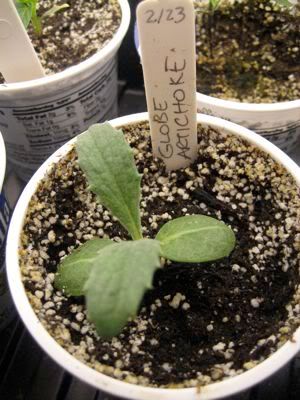
"Cynara scolymus: Introduced into California in the 1920's by Italian farmers, the artichoke has since become a chosen favorite of gourmet gardeners on this continent.
CULTURE: Artichokes and cardoon appreciate conditions that foster rapid growth. Start indoors in late January or early February; sow seeds 1/4 inch deep in 4 inch pots filled with sterile seedling mix. When the soil temperature is maintained between 50-75°F, emergence occurs in 10-20 days. Sow heavily and expect 70% germination. Of these seedlings, about 20% will not produce high quality plants. Cull out the small and albino plants. Fertilize transplants with a good all purpose liquid fertilizer such as Earth Juice Grow 2-1-1. Transplant after the danger of frost has passed, but when the seedlings can still receive 10-12 days of temperatures under 50°F, which induces earlier budding. The period of cool temperatures needed to stimulate growth and flowering varies with location and variety. Space transplants 24 inches apart in rows 3 feet apart. Work in 1 cup of our complete fertilizer or a shovelful of composted chicken manure per plant.
After the first year's harvest, remove off-types and less vigorous plants leaving a final spacing of 5-6 feet between plants. In late October, cut plants to about 8-10 inches above ground and cover with straw or leaves to keep the stump from freezing. Uncover in early April. Overwinter survival is likely but not certain. Regrowth will be offshoots of the parent plants.
DISEASE: Relatively disease-free.
HARVEST: Cut flowers before they start to open. The smaller, immature artichokes are the most tender. Rub the cut 'chokes with a slice of lemon to prevent discoloration. Store at 36°F and 100% relative humidity.
SEED SPECS: Minimum germination standard: 70%. Usual seed life: 1 year. Approximately 15-20 seeds per gram, 28 grams per ounce.
----------
WHEN TO PLANT: Sow seeds indoors at 70°F about three months before the last frost and set the plants out, preferably in a protected place with a southern exposure, when the weather has settled throughly. Some gardeners rush their artichokes with heavy feeding and early plantings under protection about four weeks before the last frost. They do this because the artichoke seems to be stimulated to form buds when the days are long and they want the plant to be sufficiently robust by that time to support the sizable "chokes".
HOW TO PLANT: Space plants about 2' apart in rows 3' apart. Keep soil out of the plant's crown when setting it out.
GROWING CONDITIONS: Globe artichokes do well in fertile, humus rich, well limed, well drained soil. Plants need careful protection where winters are cold and even then some may die from crown rot. If the root lives, it will send up new shoots the following year. Achieving a bud (edible artichoke) the first year makes all the effort worthwhile, though.
----------
PURCHASED: 1g from Territorial Seed Co. Jan '09. $4.45
STARTED SEED: Somehow I completely spaced my artichokes! Should've started the seeds a month ago - I hope it's not too late. Put them in the flat on 02/23/09. Guess we'll see at the end of the season. (Crosses fingers!) First one sprouted on 02/28/09.
HARDENED OFF:
TRANSPLANTED IN GARDEN:
DISEASE ISSUES: 04/12/09: Today I noticed that I have what I think is Bacterial Leaf Spot. I clipped off the effected areas and bleached the scissors afterwards. I hope that's enough for now. I also need to get some 5-10-10 to help the plant recover, or so I'm advised. It's spread by moisture and water. Hard to escape that in the PNW. A copper based organic fungicide may help. I'm not there yet.
INSECT ISSUES:
HARVEST YEILD & DURATION:
OTHER NOTES:
03/02/09

03/16/09

03/23/09

Sunday, January 25, 2009
Snowy Sunday Morning
Wednesday, January 21, 2009
If you can't garden, there's always shopping
I received a lovely little gift card for Christmas to the local nursery. It's been burning a hole in my pocket ever since. Of course it's winter and freezing out so I didn't even bother to look at what plants they had outdoors. The kiddlet and I made a bee-line for the indoor part. I bought a few "unexciting" things like a soil thermometer, a compost thermometer (*squee* I've always wanted one of those! lol), a rain gauge and two boxes of dolomite lime to add to the veggie beds. I'm a dork I know. But it'll be a great help at planting at the correct time and getting my compost pile up to a good "cooking" temperature. Weee! These things make me happy. That purchase blew through the card in a right hurry. It was fun though. If it's at all warm (you know, above freezing!) tomorrow I'll till the lime in and attach the rain gauge somewhere appropriate. I might even tell you just how cold the soil is!
Monday, January 19, 2009
Compost Bins!
It's funny when DH gets his mind set on something nothing can stop him. So when monday rolled around and he had the day off he decided that I needed compost bins. Now in theory this is a grand idea! I love composting and would love to have bins. However our yard is pretty small and finding a large sunny spot is a bit of a challenge. But like I said when DH is set on it - it matters not what I think. So the spot I was thinking about for a small fruit tree or coffee patio is now the new home for a three bin compost system. Of course he didn't exactly follow these instructions but you get the general idea and size of the behemoth!
The reality is, it really has nothing to do with me or the garden. It has to do with motorcycles. Recently DH was offered a lot of pretty decent free lumber from a family member. Well DH being DH took it all gleefully. Until he got home. And tried to find a place to put it all! Needless to say useless wood boards are now taking up precious space he could be storing useless motorcycle parts in! The horror. lol However this does work out greatly to my (and the gardens!) advantage.
So he even braved the cold weather (38°-ish) to start construction. He's trying so hard to use up the wood that he's ignoring one of the main principals of composting which is it needs air. He wants to use all boards on all sides (no mesh) but I need to put my foot down - compost needs air to break down! There has to be mesh in there somewhere! I think I can still convince him as he got it half made before running out of 2 1/2" nails to finish it. He did manage to run off to McDepot to get some more but I'm not sure when he'll get a chance to finish it.
I'm hoping that by late spring, early summer we'll have finished up all the work on that 1/2 of the yard. I can't tell you how great that makes me feel! Of course it's never done - there's a lot of work to be put into the half we haven't touched yet. Building a patio is a PITA. Of course I'd love some place to relax and enjoy my back yard from, so it must be done!
The reality is, it really has nothing to do with me or the garden. It has to do with motorcycles. Recently DH was offered a lot of pretty decent free lumber from a family member. Well DH being DH took it all gleefully. Until he got home. And tried to find a place to put it all! Needless to say useless wood boards are now taking up precious space he could be storing useless motorcycle parts in! The horror. lol However this does work out greatly to my (and the gardens!) advantage.
So he even braved the cold weather (38°-ish) to start construction. He's trying so hard to use up the wood that he's ignoring one of the main principals of composting which is it needs air. He wants to use all boards on all sides (no mesh) but I need to put my foot down - compost needs air to break down! There has to be mesh in there somewhere! I think I can still convince him as he got it half made before running out of 2 1/2" nails to finish it. He did manage to run off to McDepot to get some more but I'm not sure when he'll get a chance to finish it.
I'm hoping that by late spring, early summer we'll have finished up all the work on that 1/2 of the yard. I can't tell you how great that makes me feel! Of course it's never done - there's a lot of work to be put into the half we haven't touched yet. Building a patio is a PITA. Of course I'd love some place to relax and enjoy my back yard from, so it must be done!
Sunday, January 4, 2009
I'm cold.
It's snowing. Again.
To cheer myself up I've been drooling over the seed catalogs. I'm so excited for the veggie garden this year I can hardly stand it! I need another acre just to grow everything I want to. How will I ever narrow down my choices? ::sips tea, drools some more::
To cheer myself up I've been drooling over the seed catalogs. I'm so excited for the veggie garden this year I can hardly stand it! I need another acre just to grow everything I want to. How will I ever narrow down my choices? ::sips tea, drools some more::
Friday, January 2, 2009
Snow no!
We flew back to the East Coast for nearly three weeks to spend the holidays with DH's family. We left on Dec 13th, on the 14th it started snowing at home and never stopped! It all melted (finally) a few days ago, just before we arrived back.

Photo taken by thespeak
All that snow created quite a bit of havoc that I'm glad we missed out on. Portland isn't used to getting so much snow - it's the most we've seen in 50 years! (19" fell) However there was no one here that could take care of any of my plants. I'm very, very glad I did that one last day of clean up before we left - I think I may have saved quite a few of my bulbing flowers. However the poor New Zealand Flax doesn't look so hot. It snowed again last night and mostly all melted today but still the roads were bad and all the plants seem to be languishing under the weight of the cold heavy wet snow. I think I'm going to have to research a bit to see if there's anything I can do to help out the poor flax. I haven't had time to get out and examine the rest of the gang. I'm hoping they're not too bad off... fingers crossed!

Photo taken by thespeak
All that snow created quite a bit of havoc that I'm glad we missed out on. Portland isn't used to getting so much snow - it's the most we've seen in 50 years! (19" fell) However there was no one here that could take care of any of my plants. I'm very, very glad I did that one last day of clean up before we left - I think I may have saved quite a few of my bulbing flowers. However the poor New Zealand Flax doesn't look so hot. It snowed again last night and mostly all melted today but still the roads were bad and all the plants seem to be languishing under the weight of the cold heavy wet snow. I think I'm going to have to research a bit to see if there's anything I can do to help out the poor flax. I haven't had time to get out and examine the rest of the gang. I'm hoping they're not too bad off... fingers crossed!
Subscribe to:
Posts (Atom)
